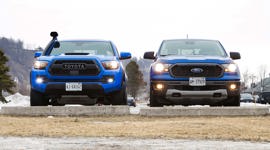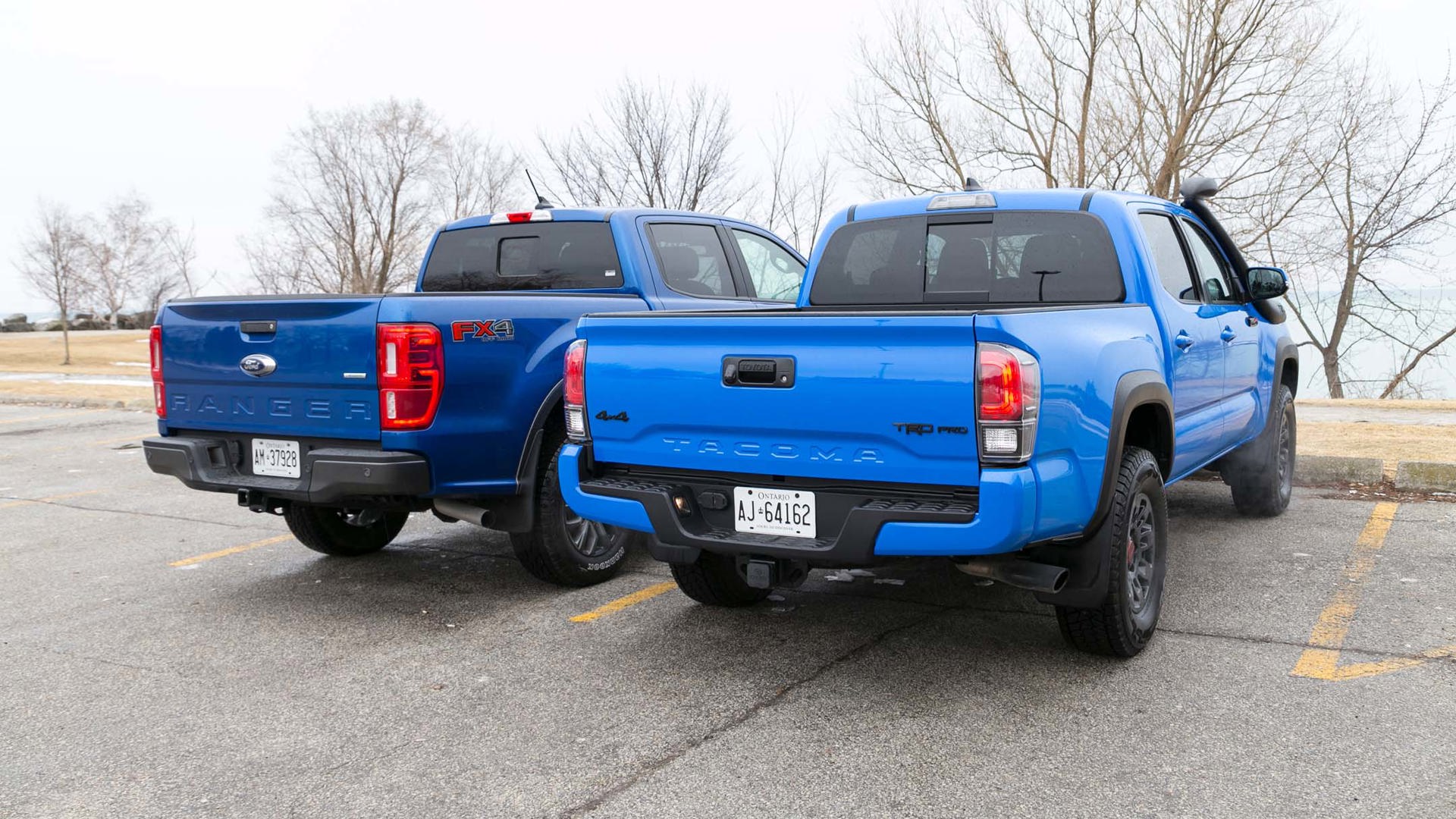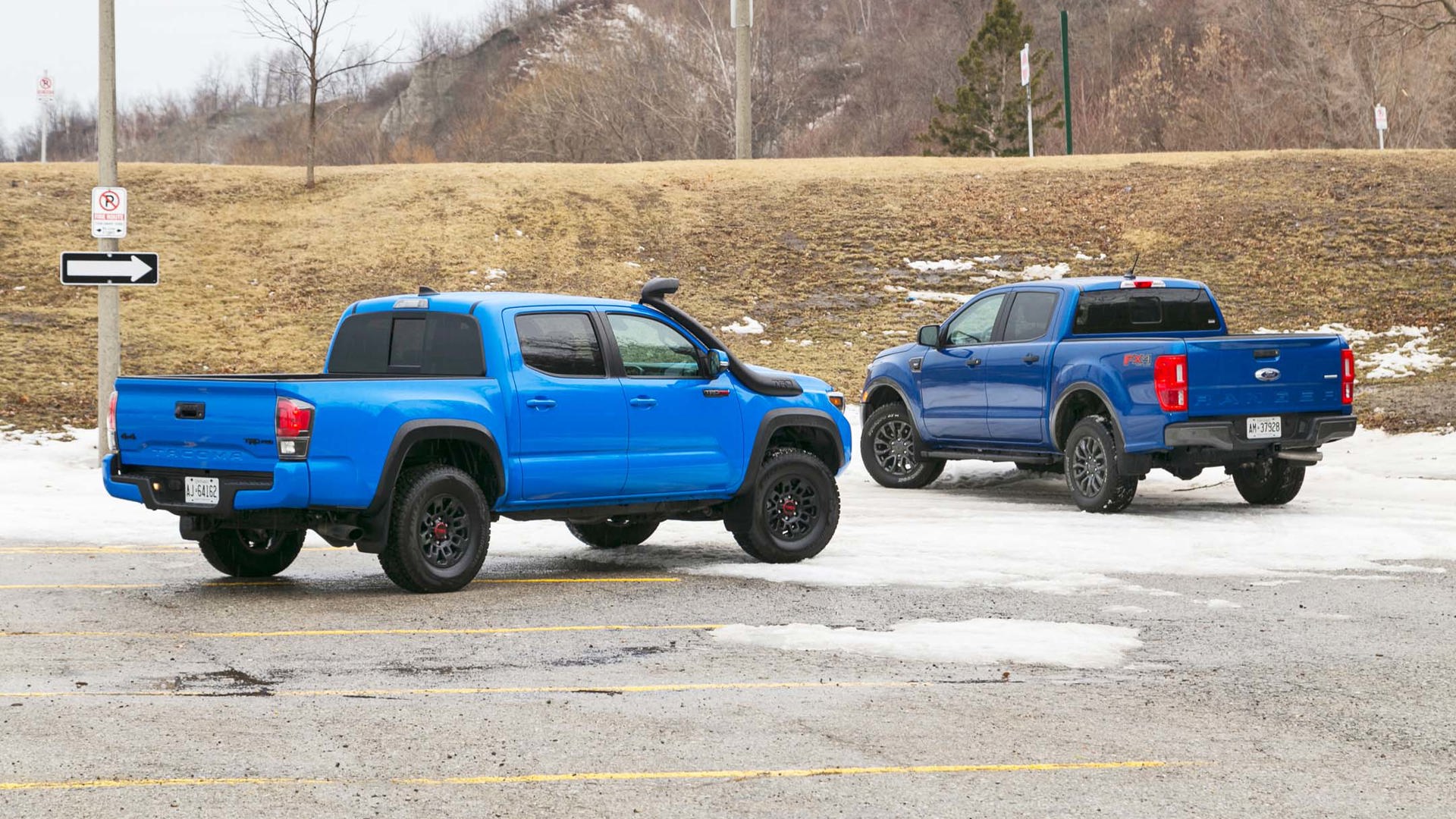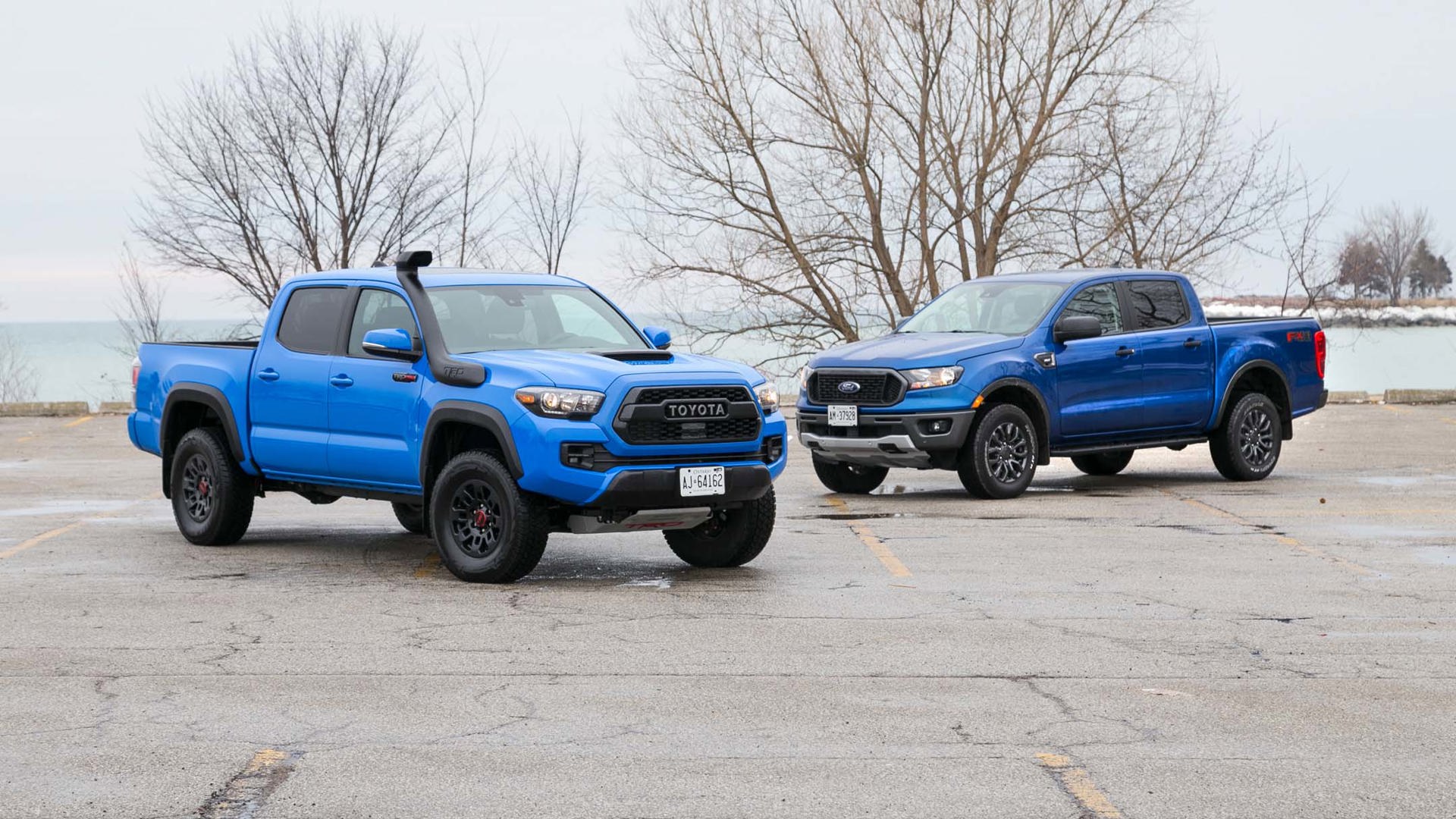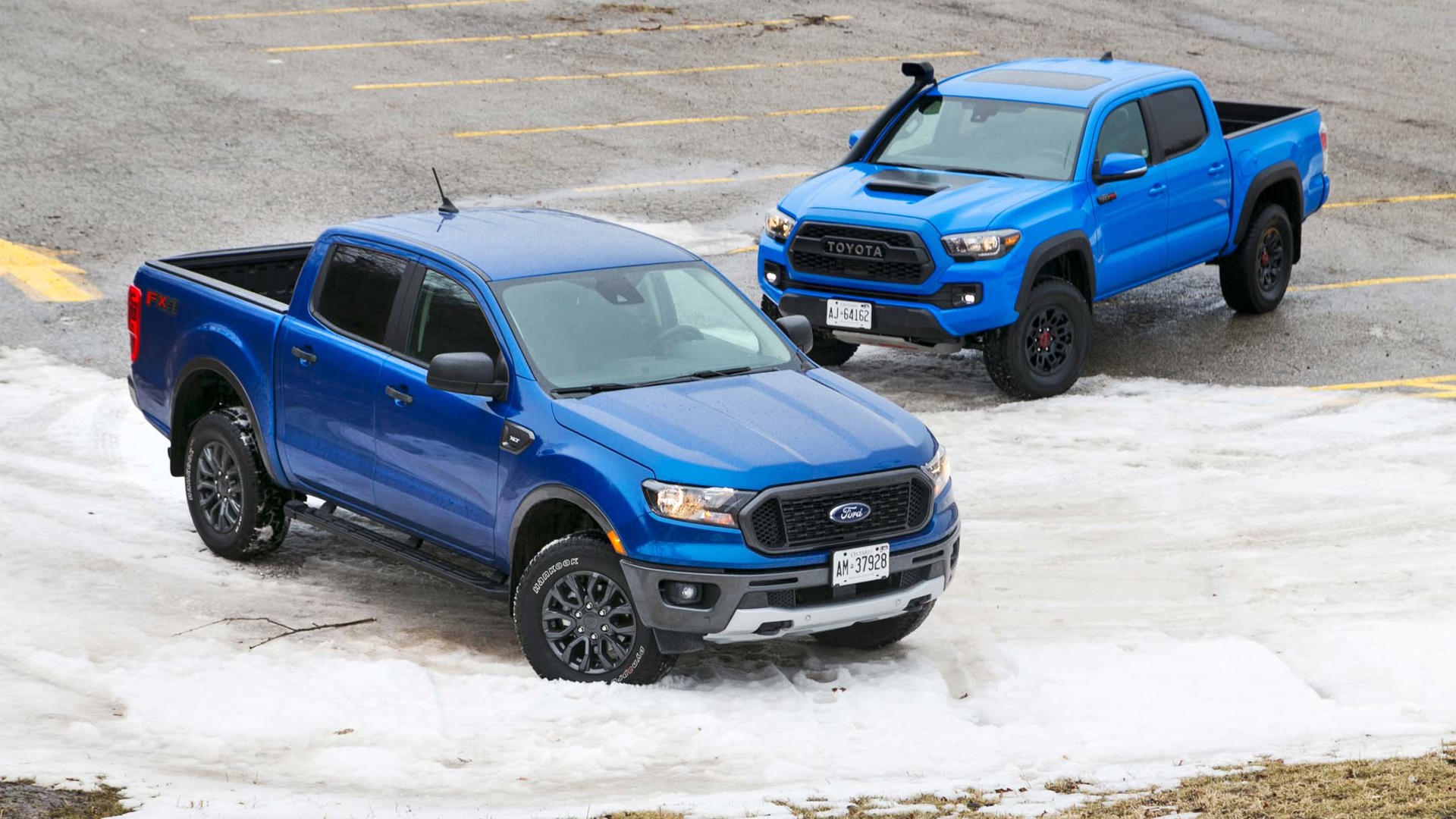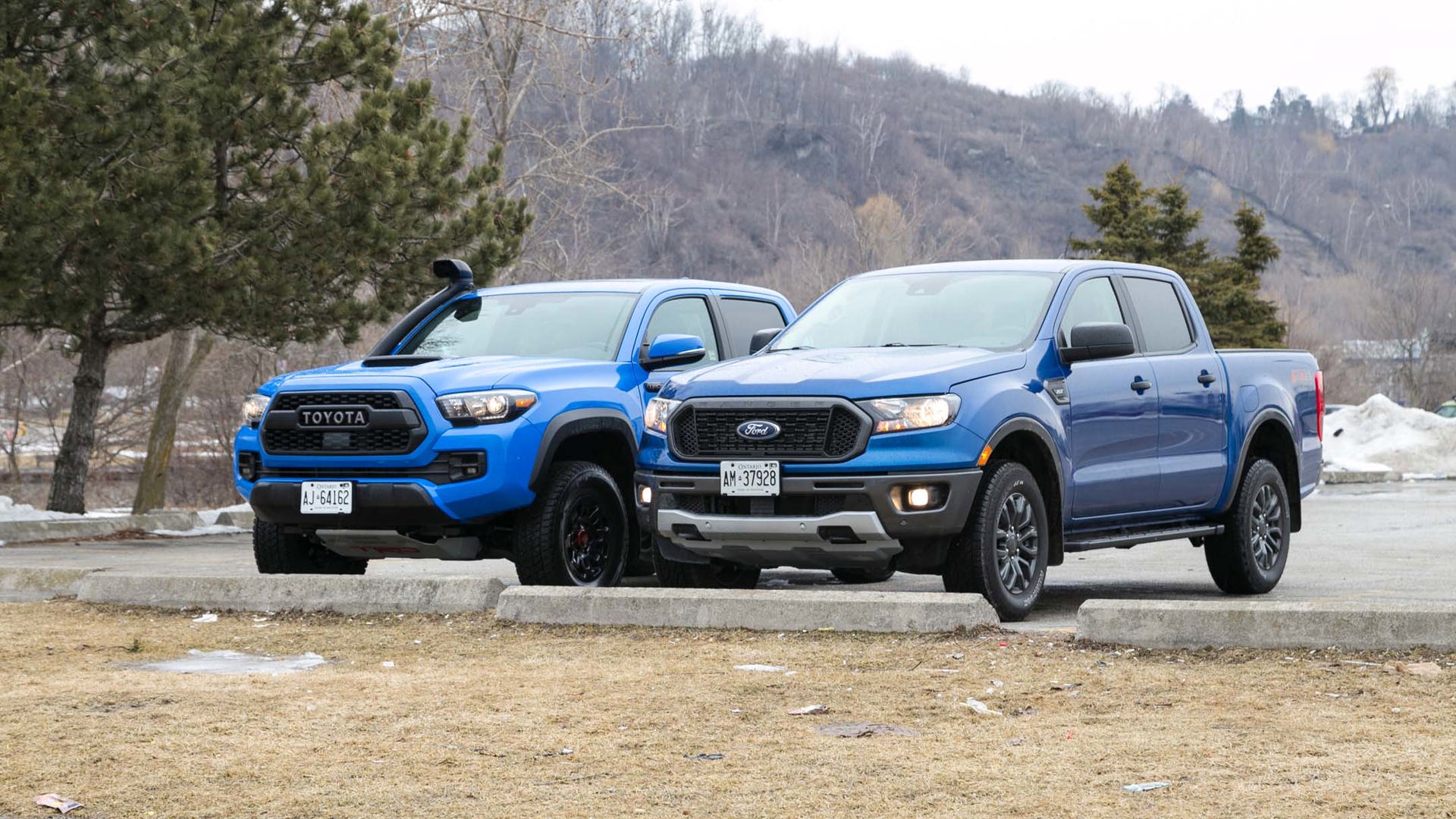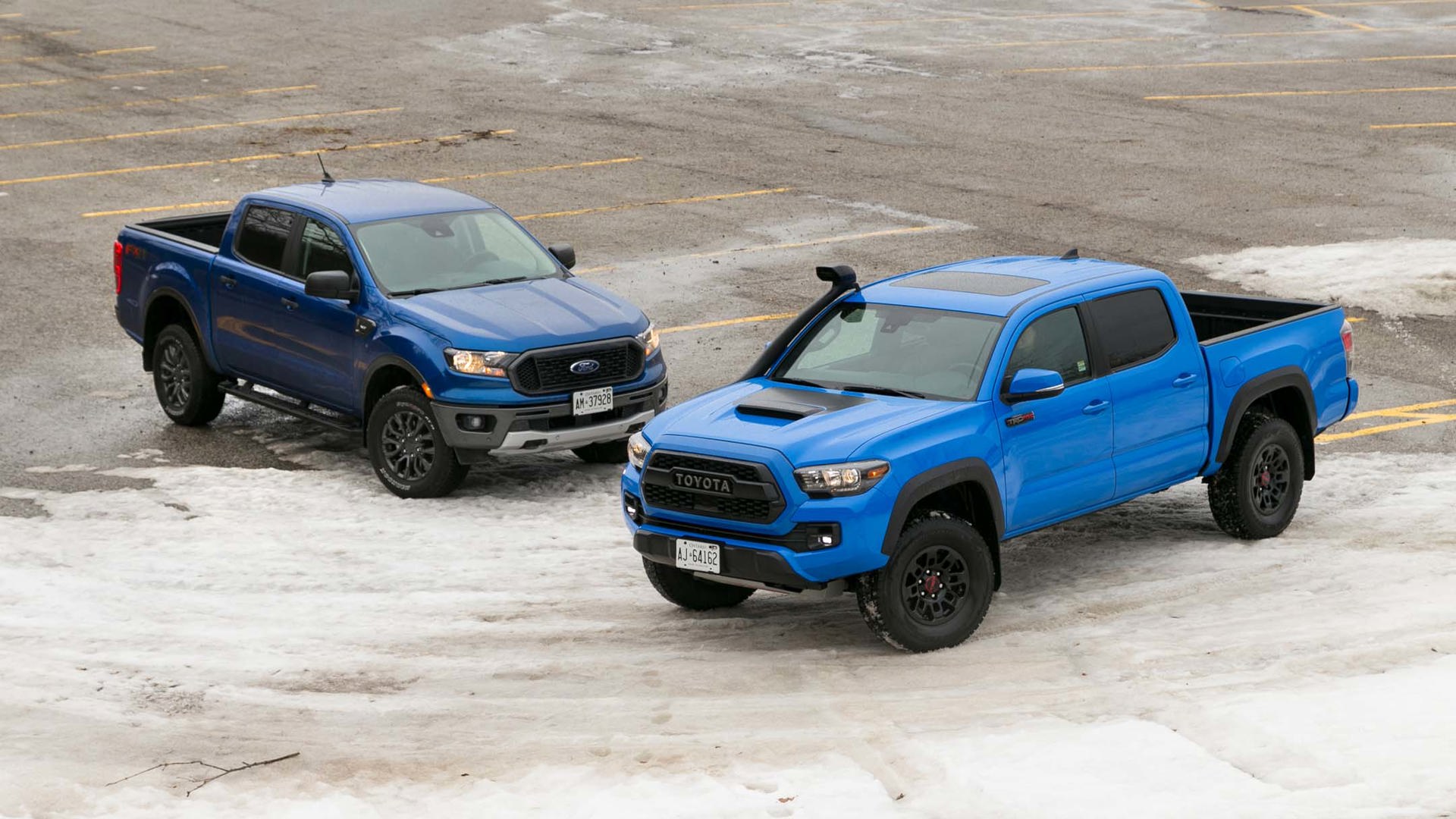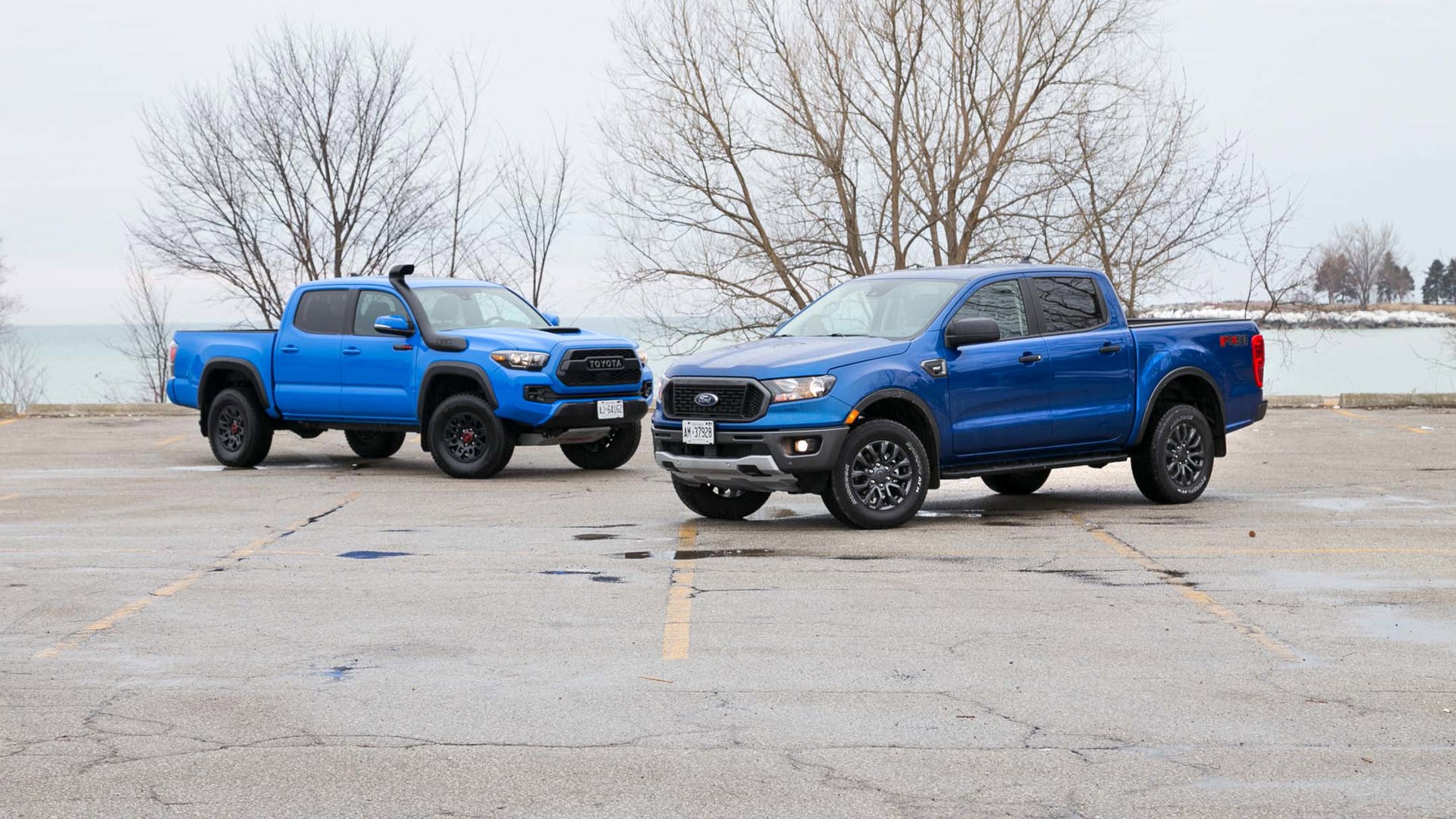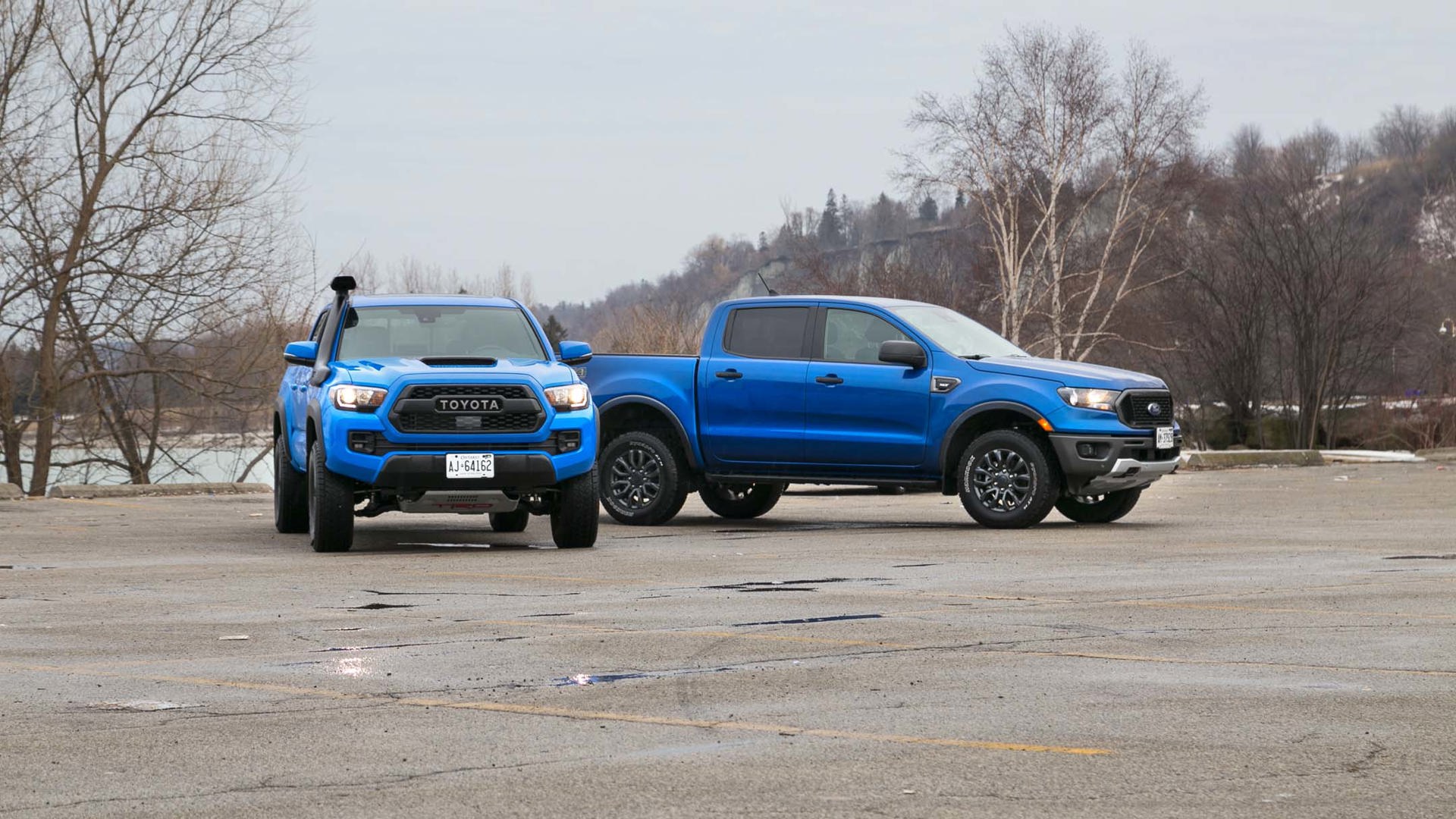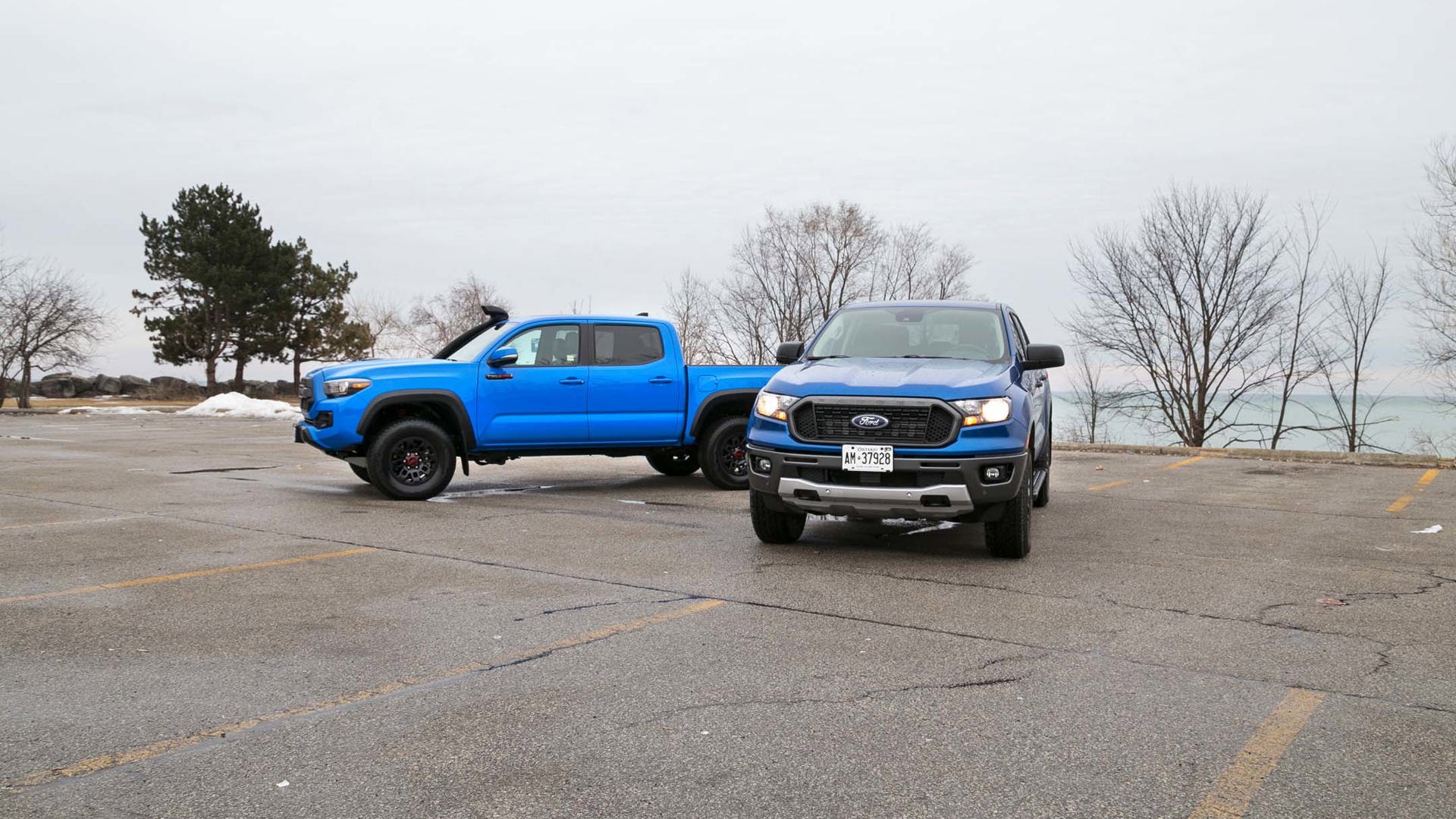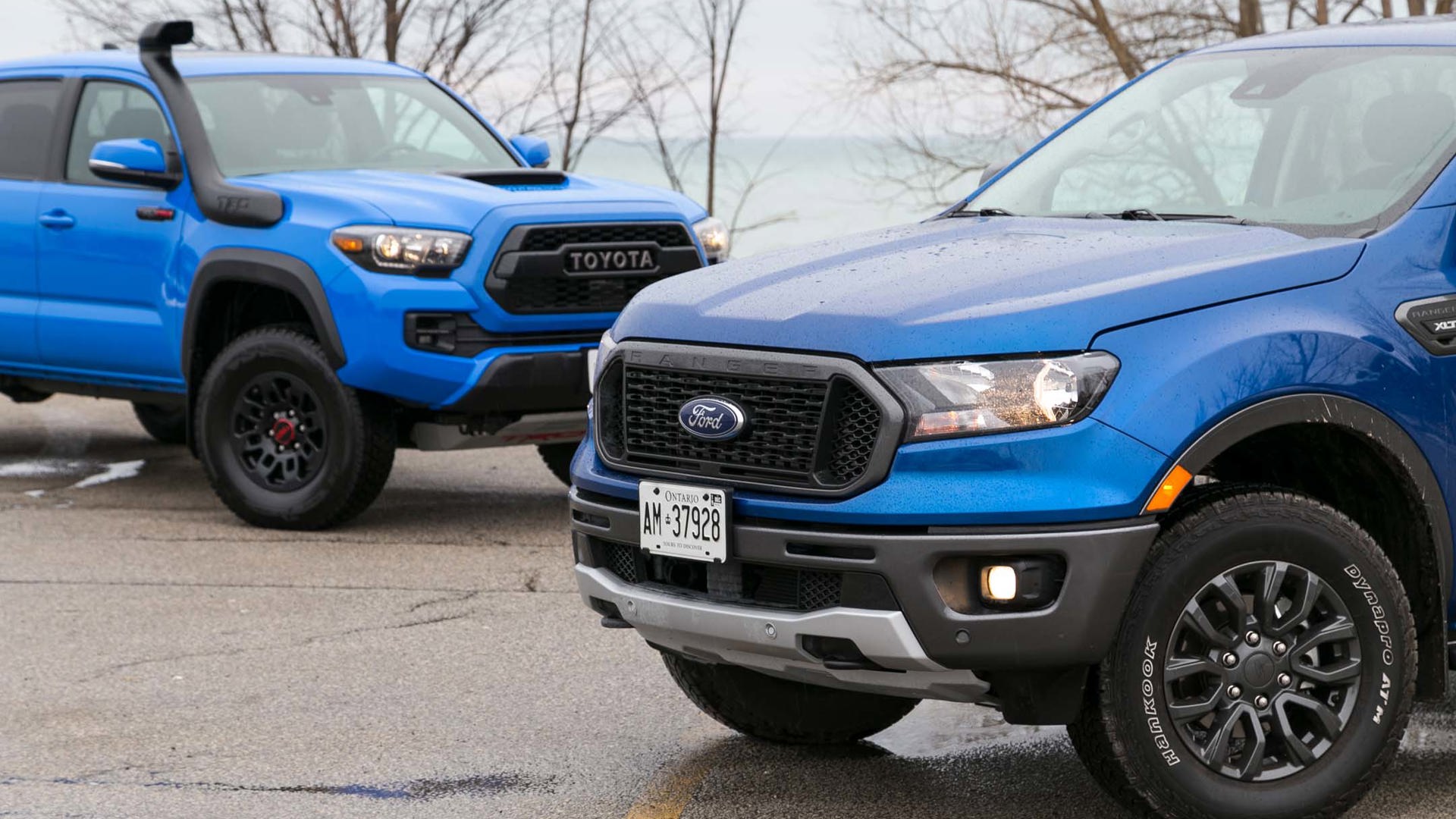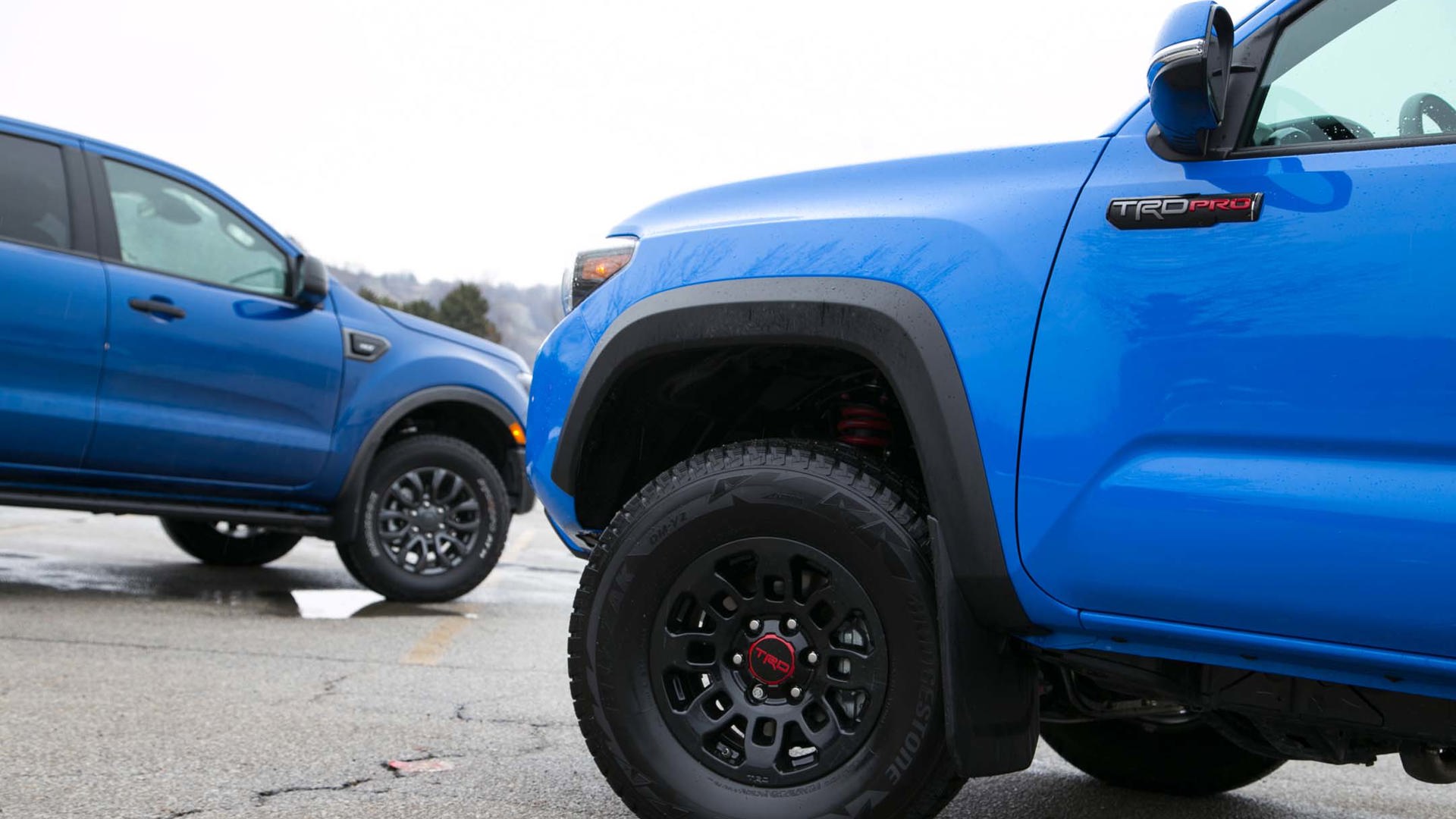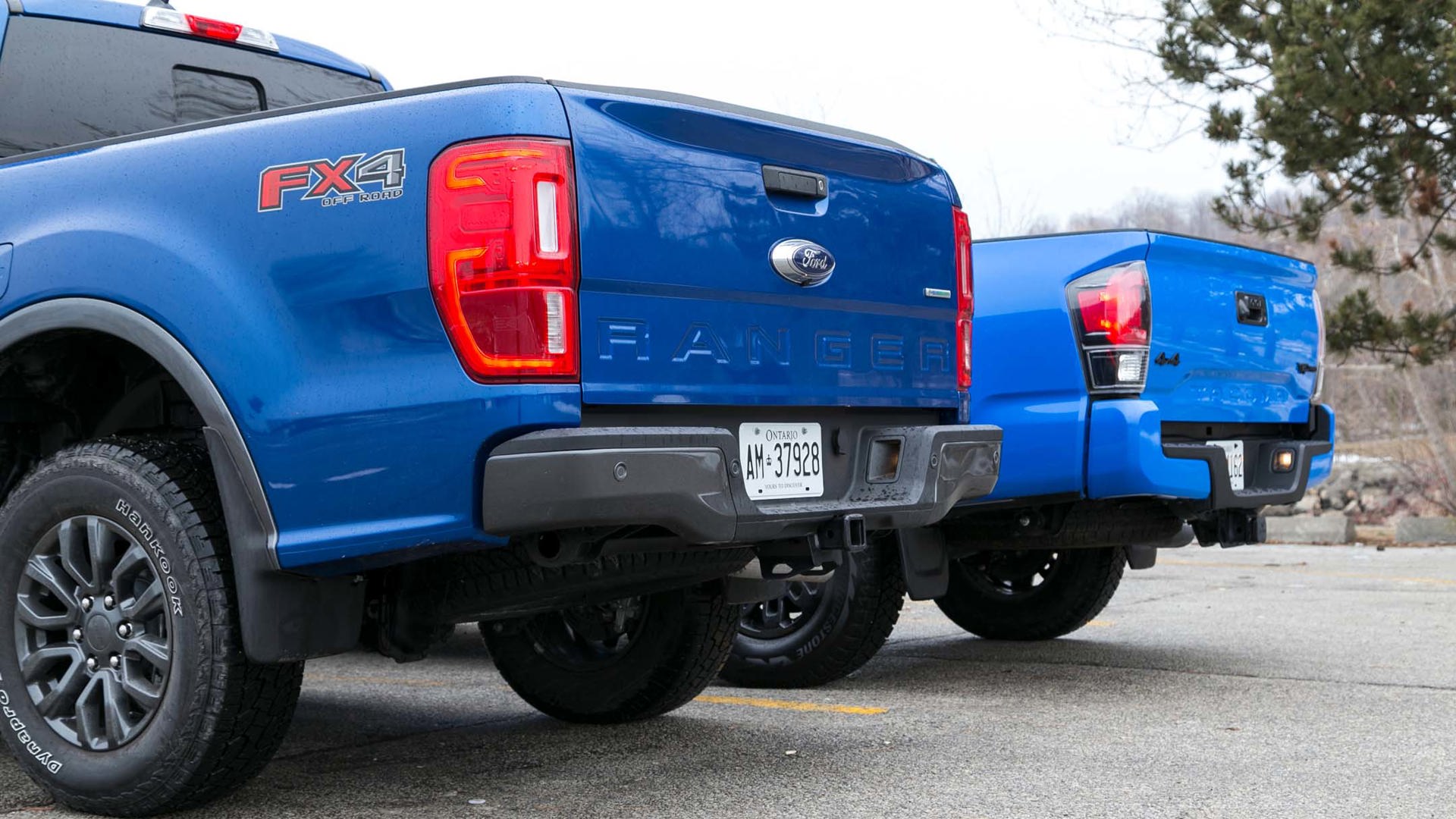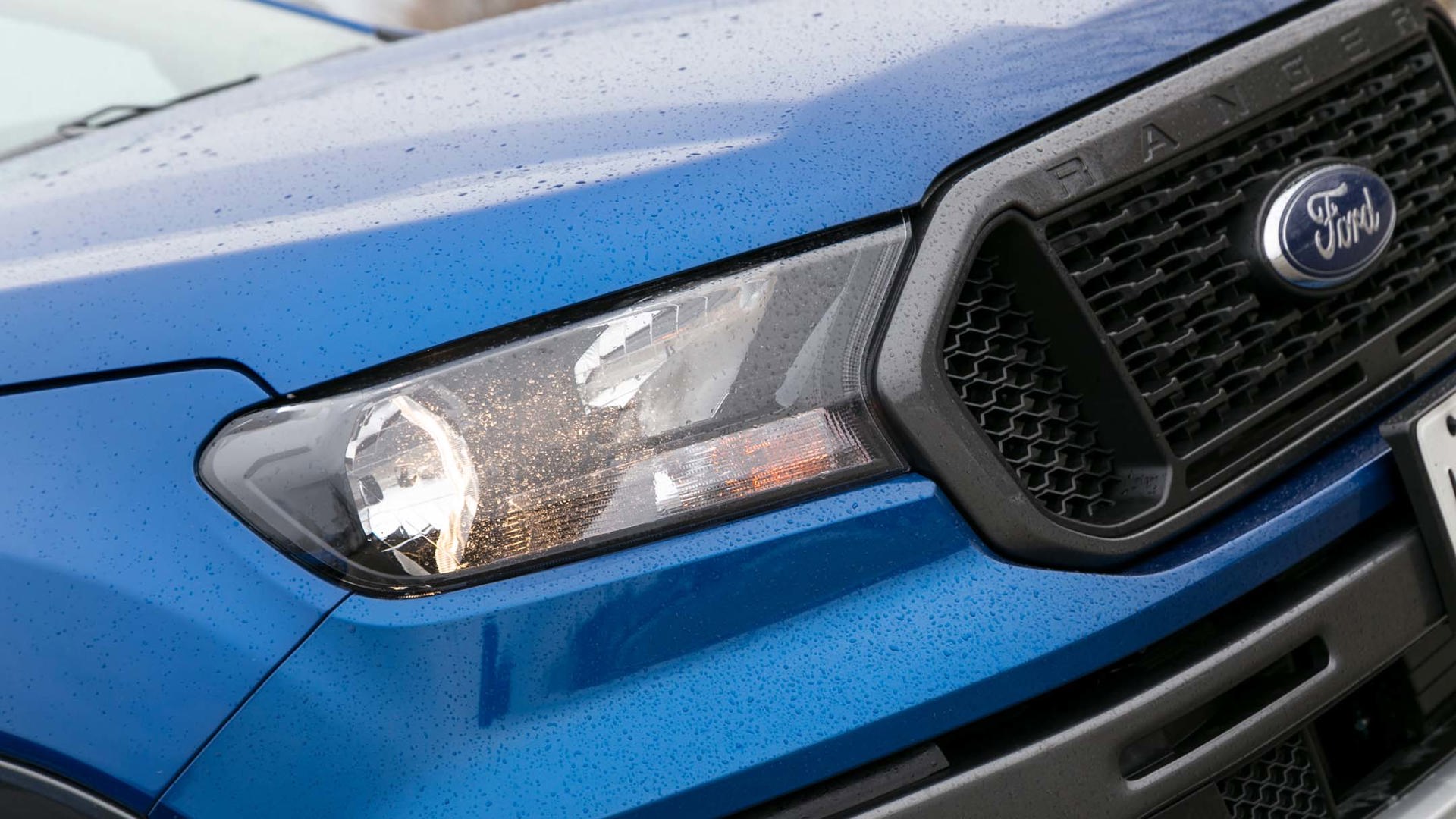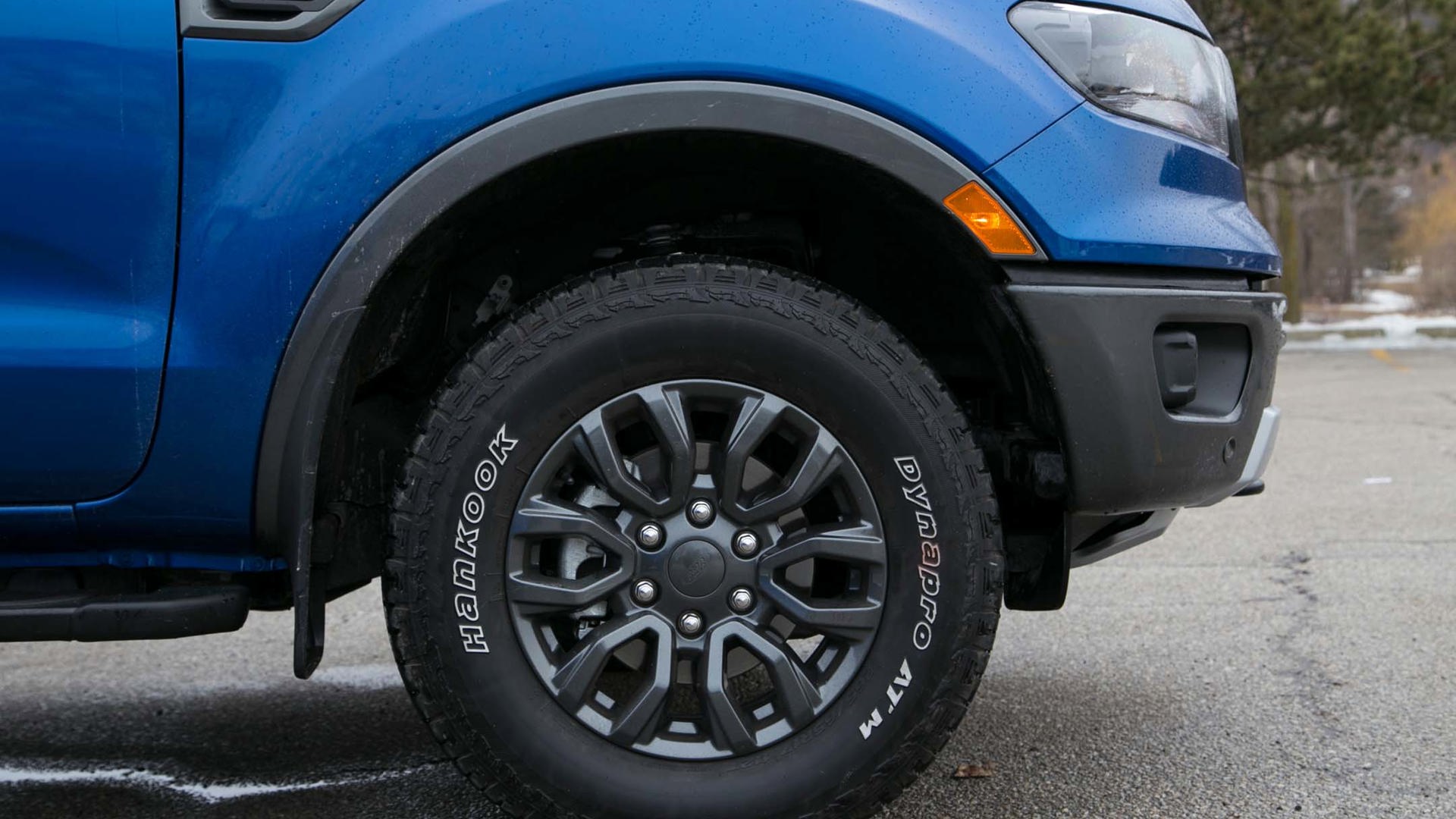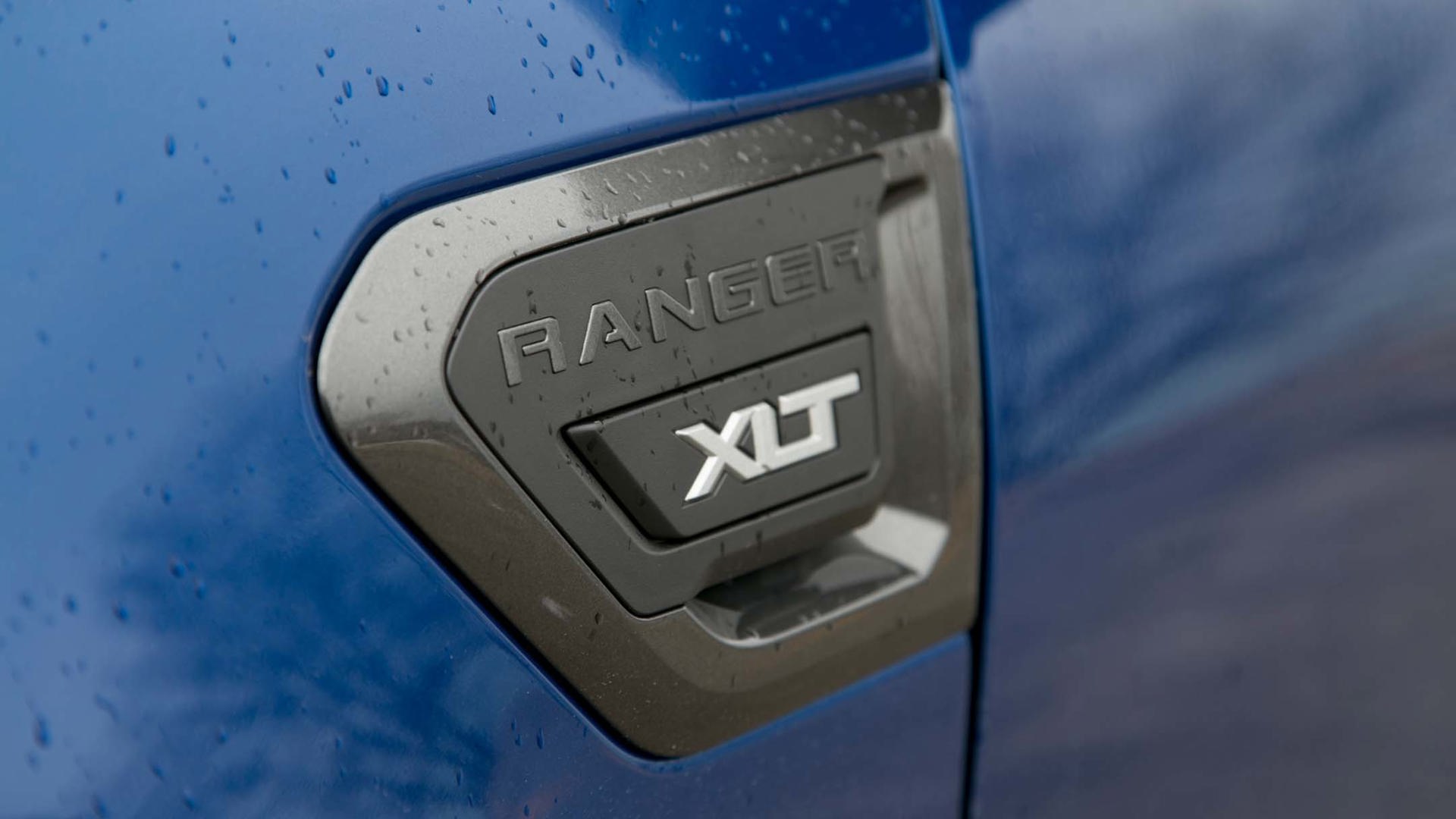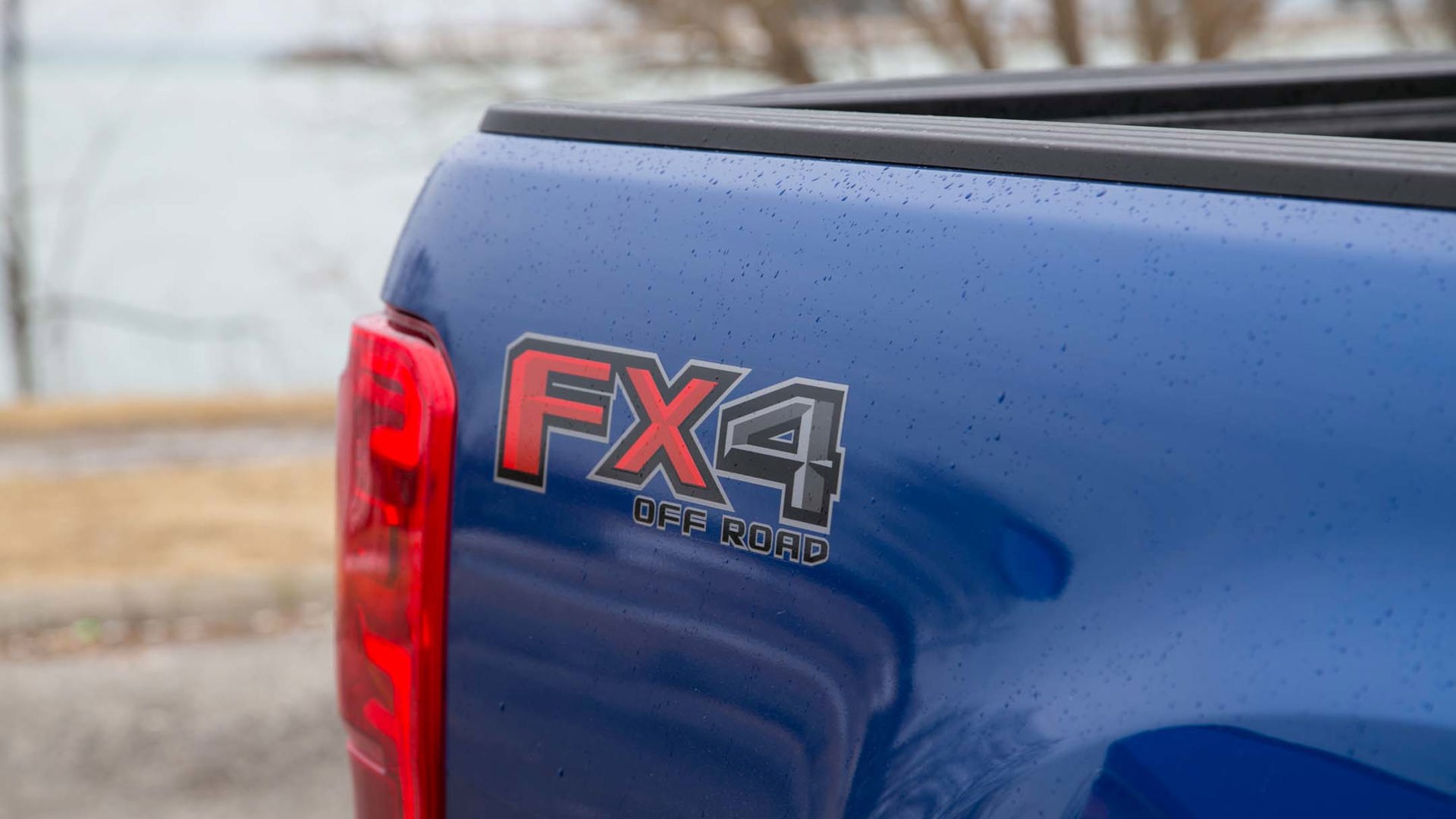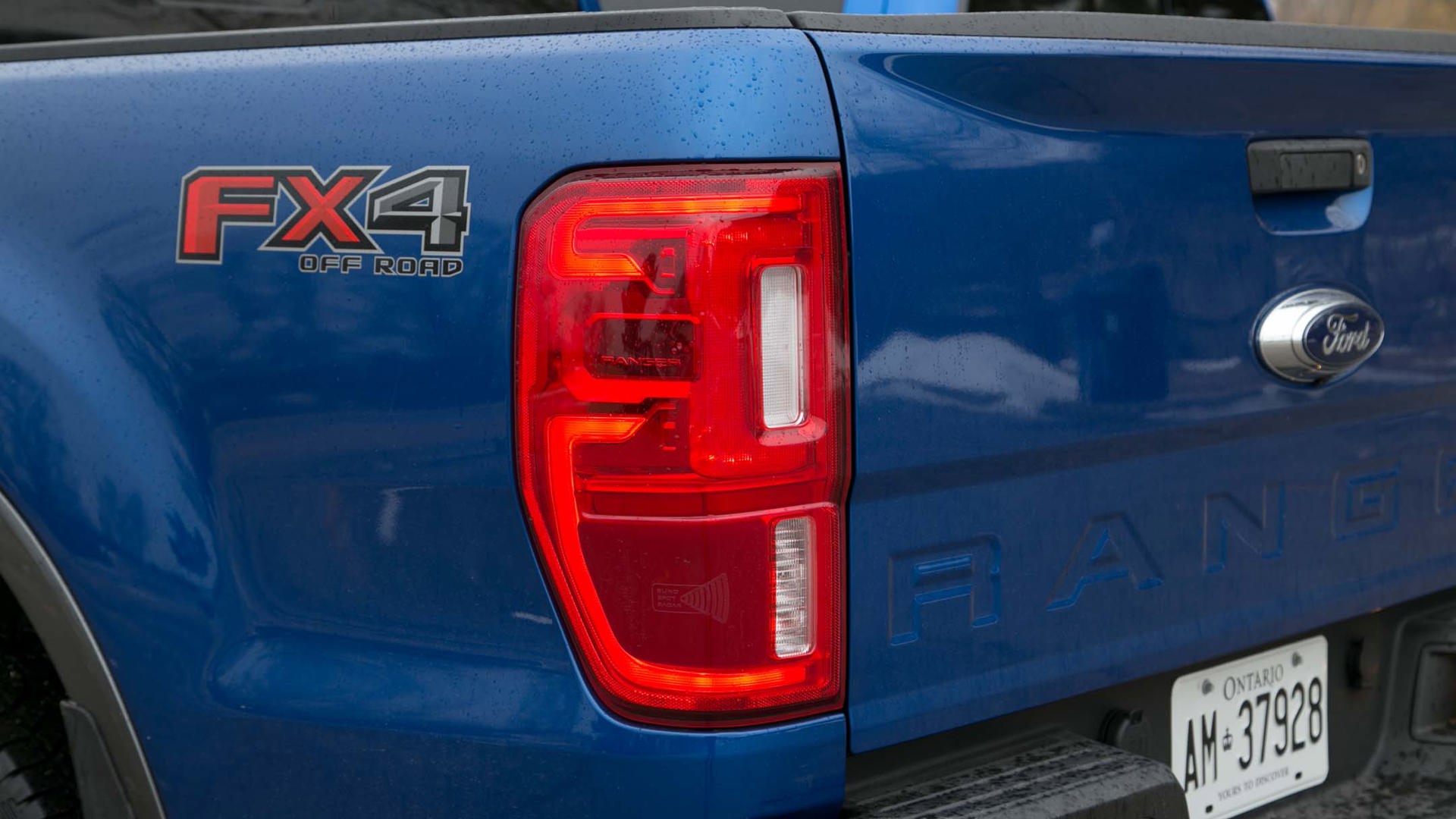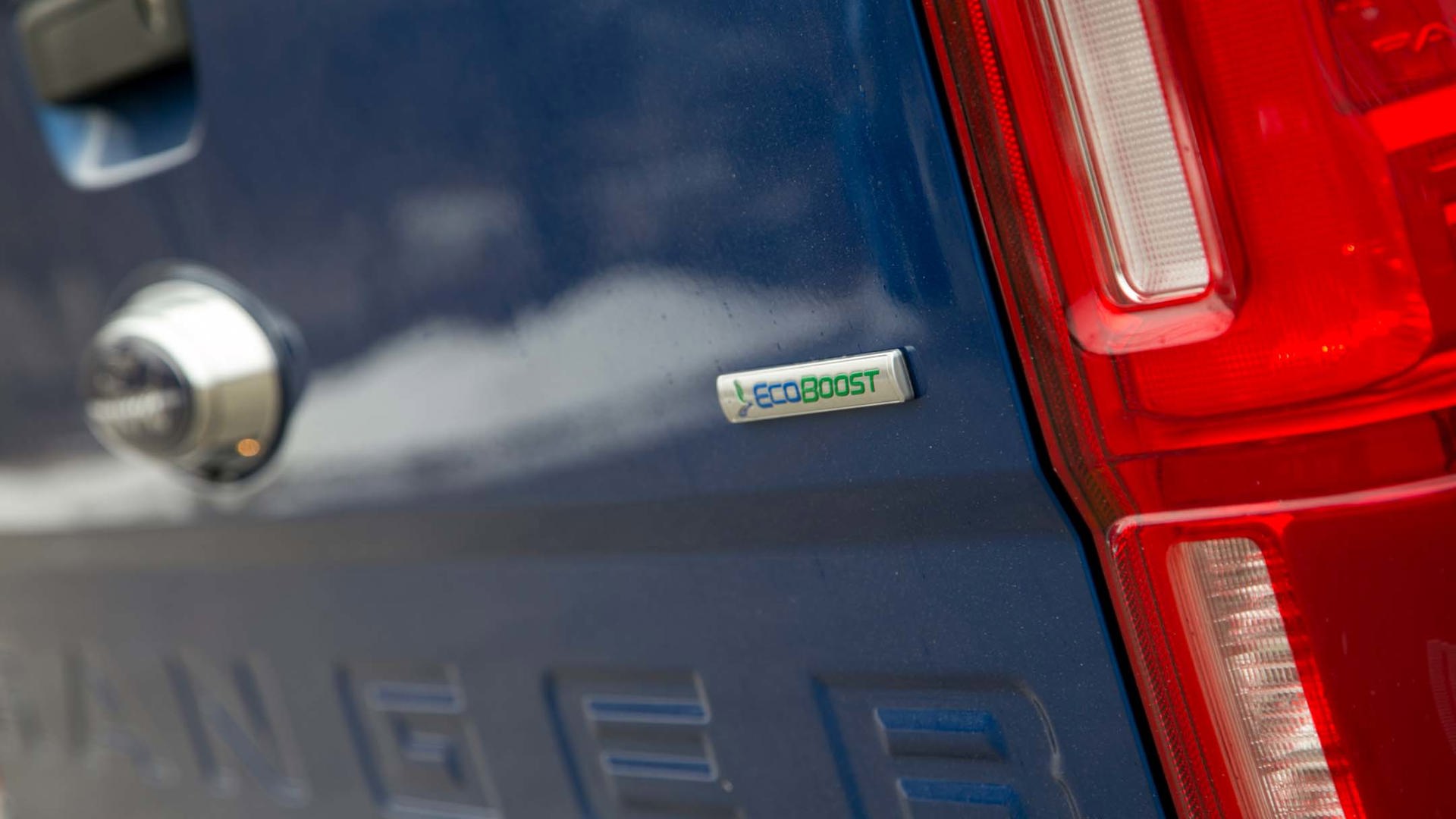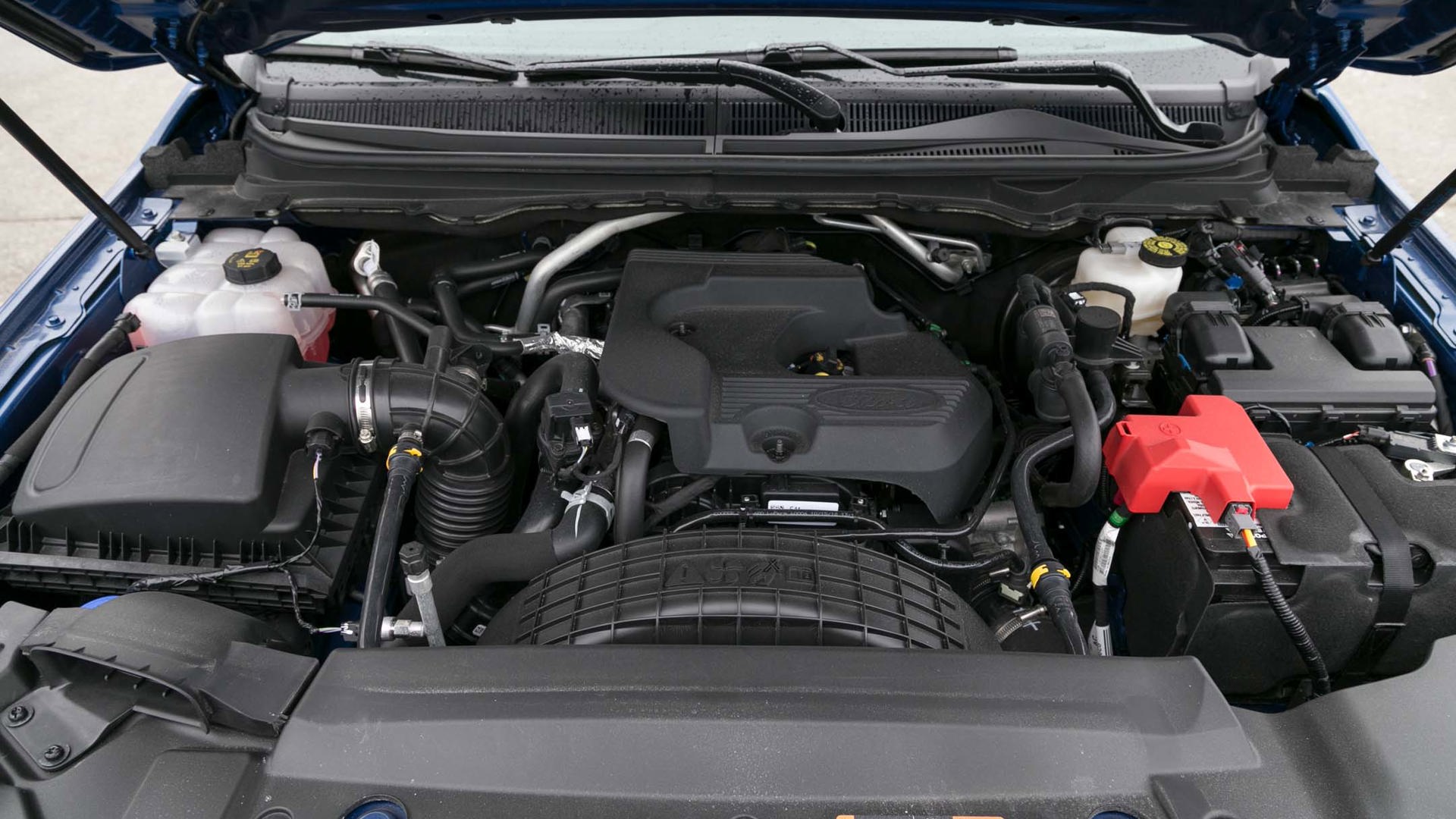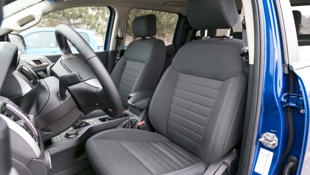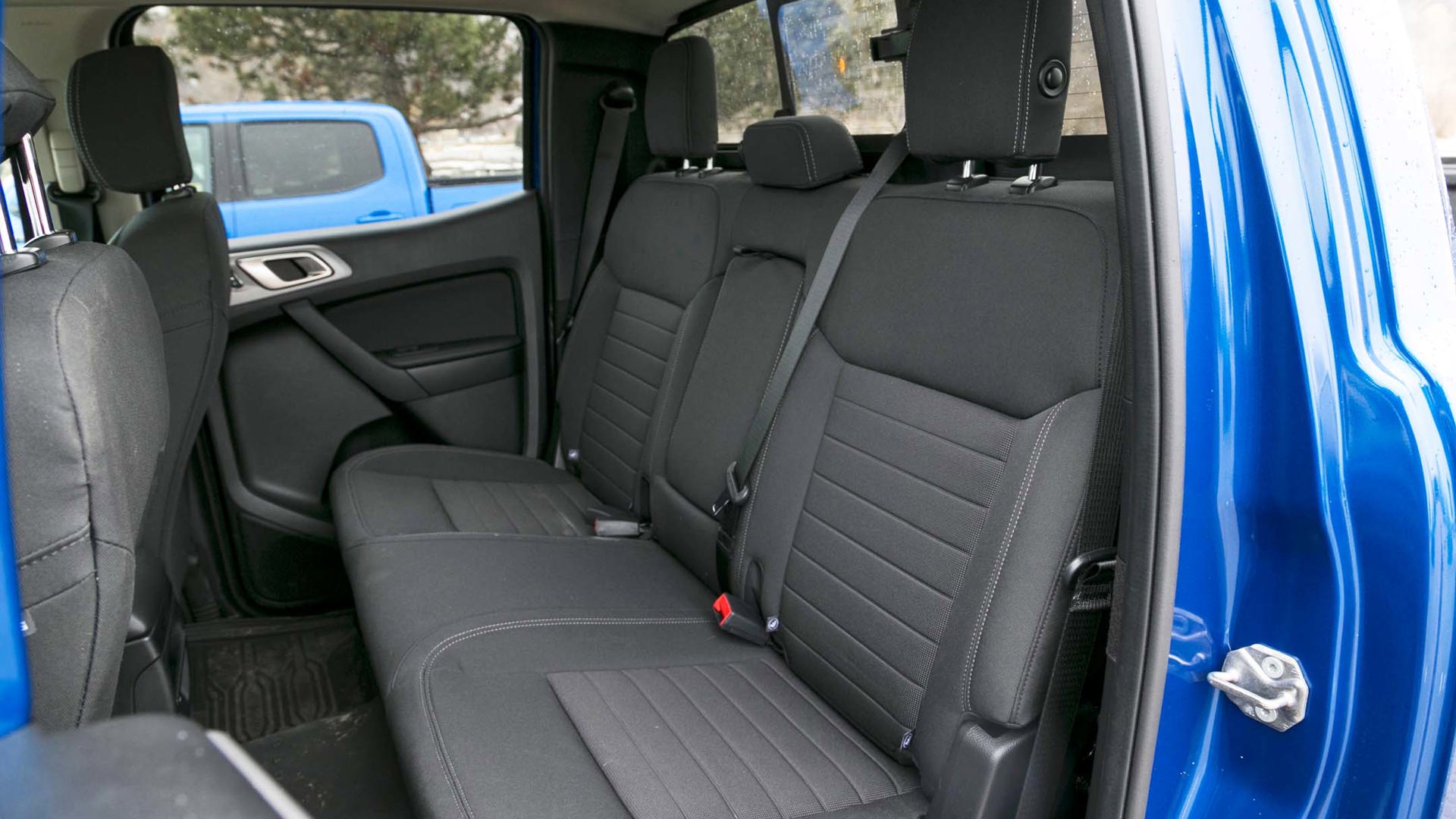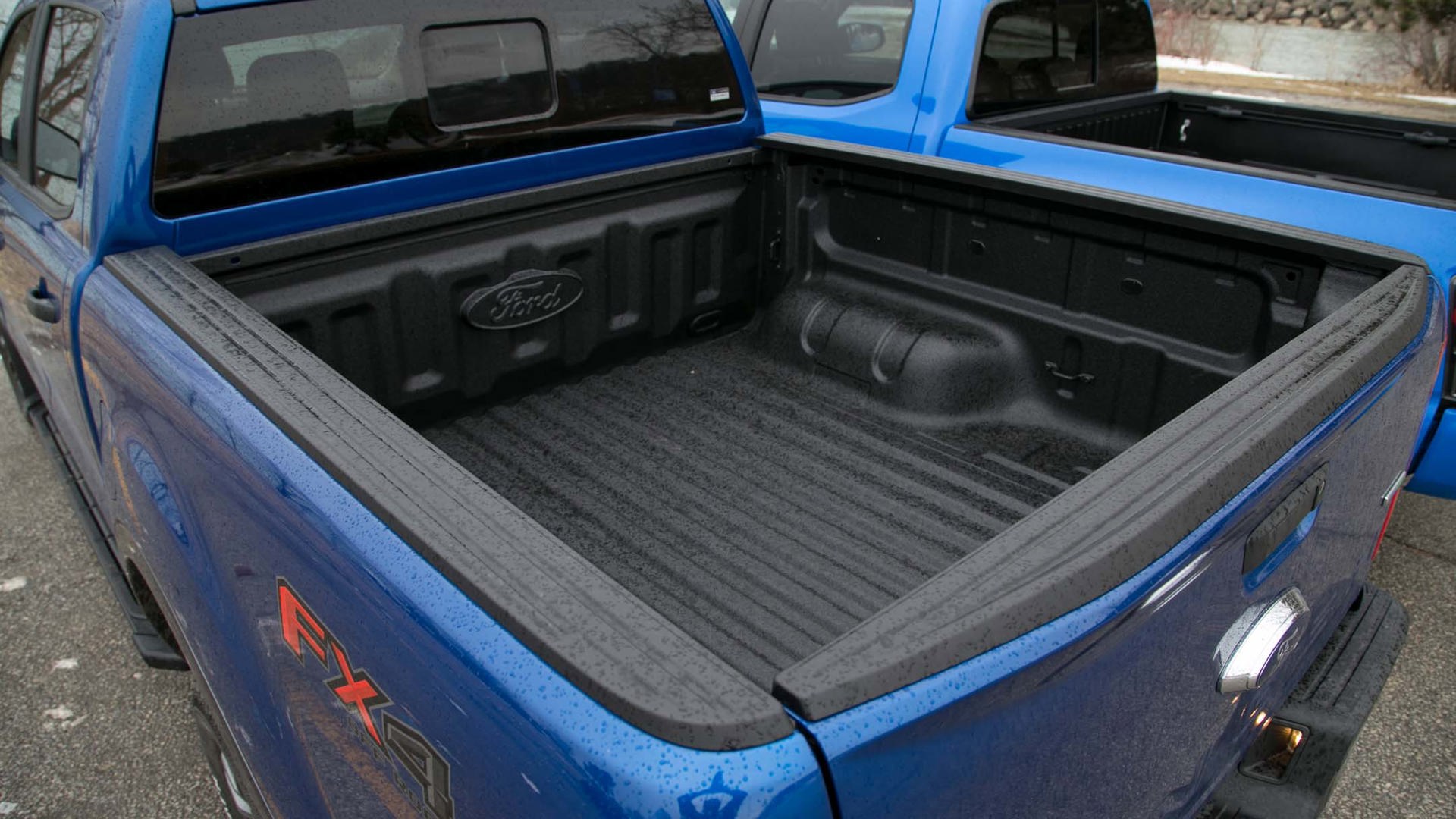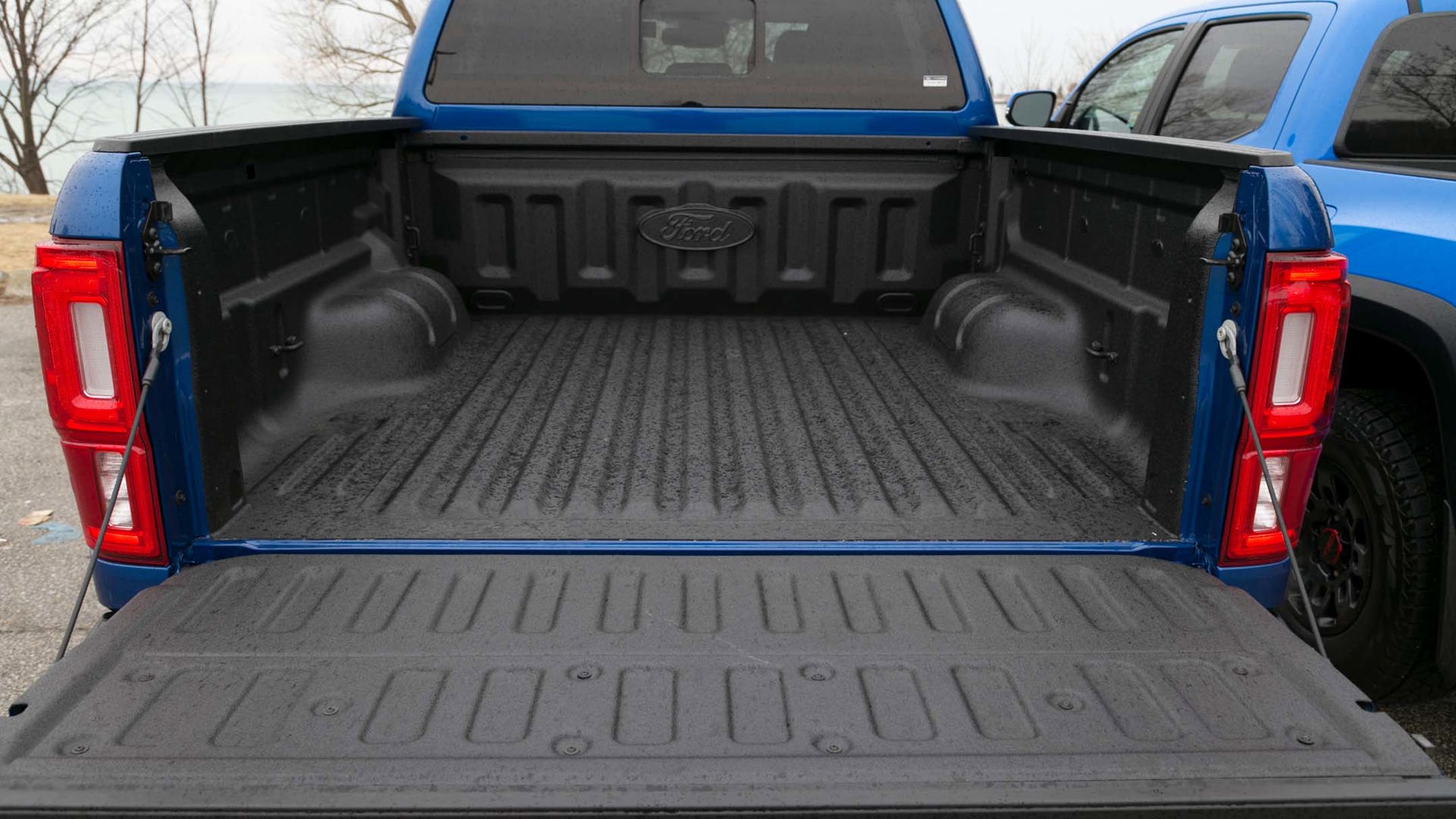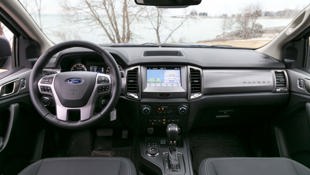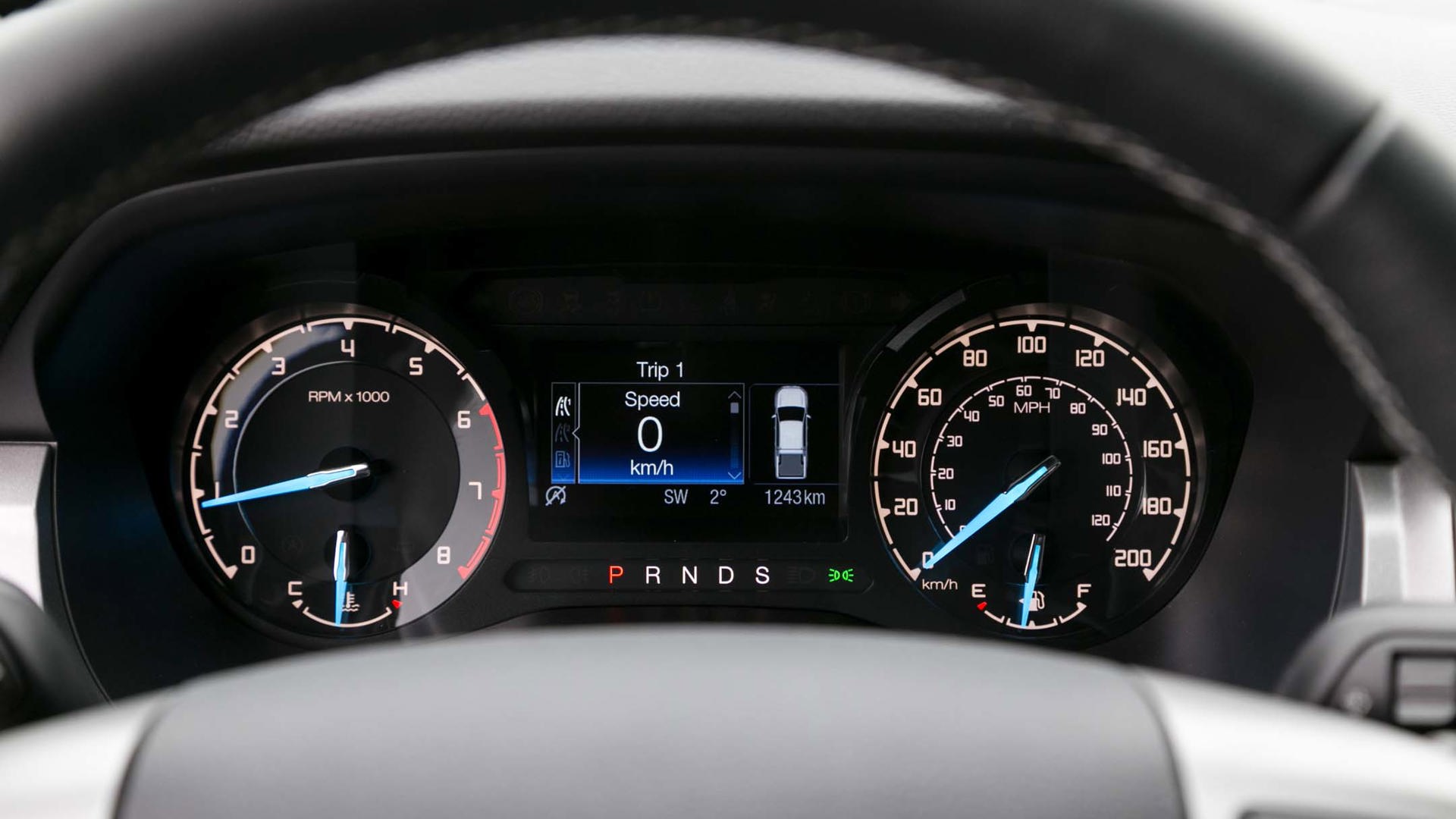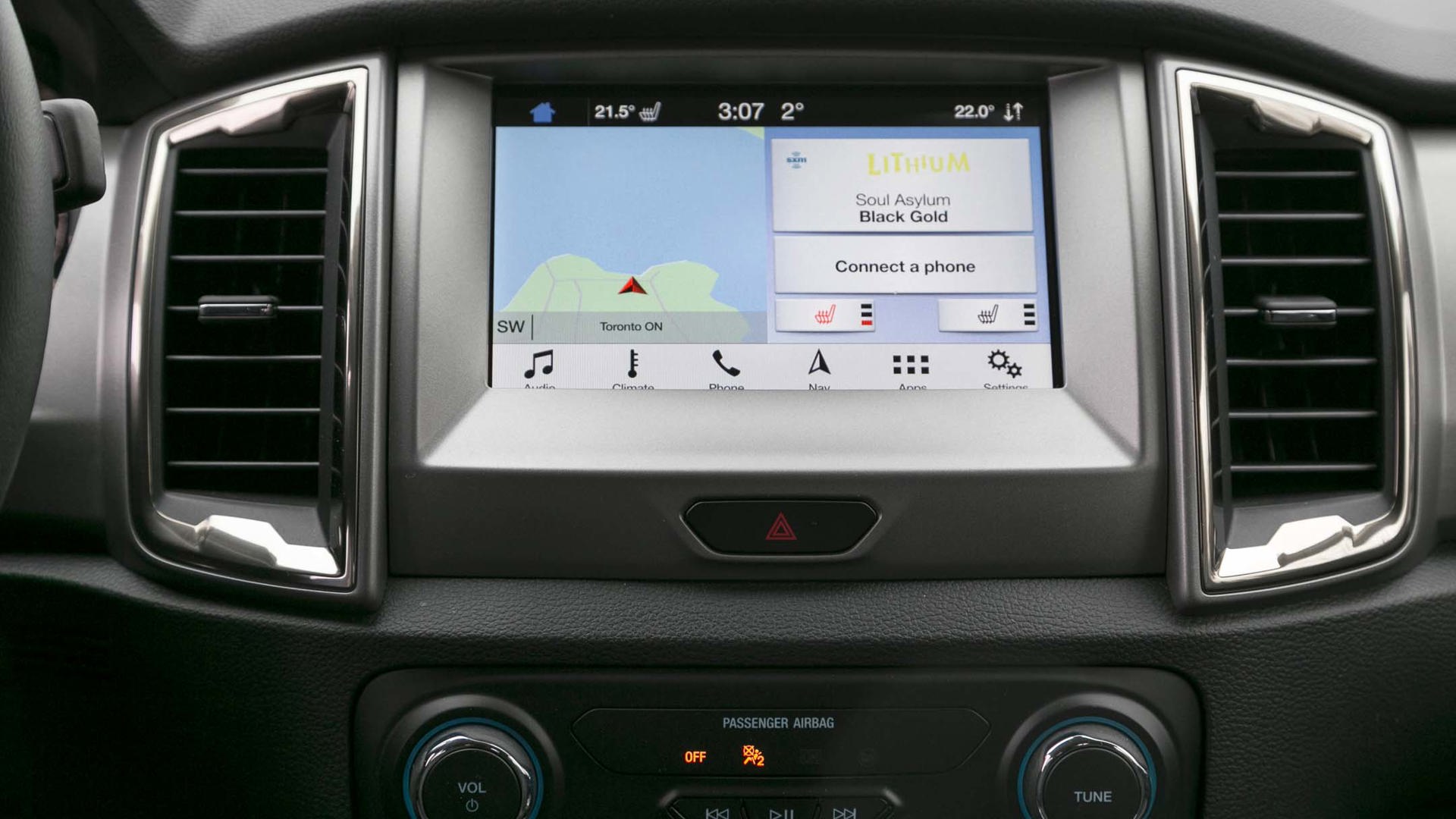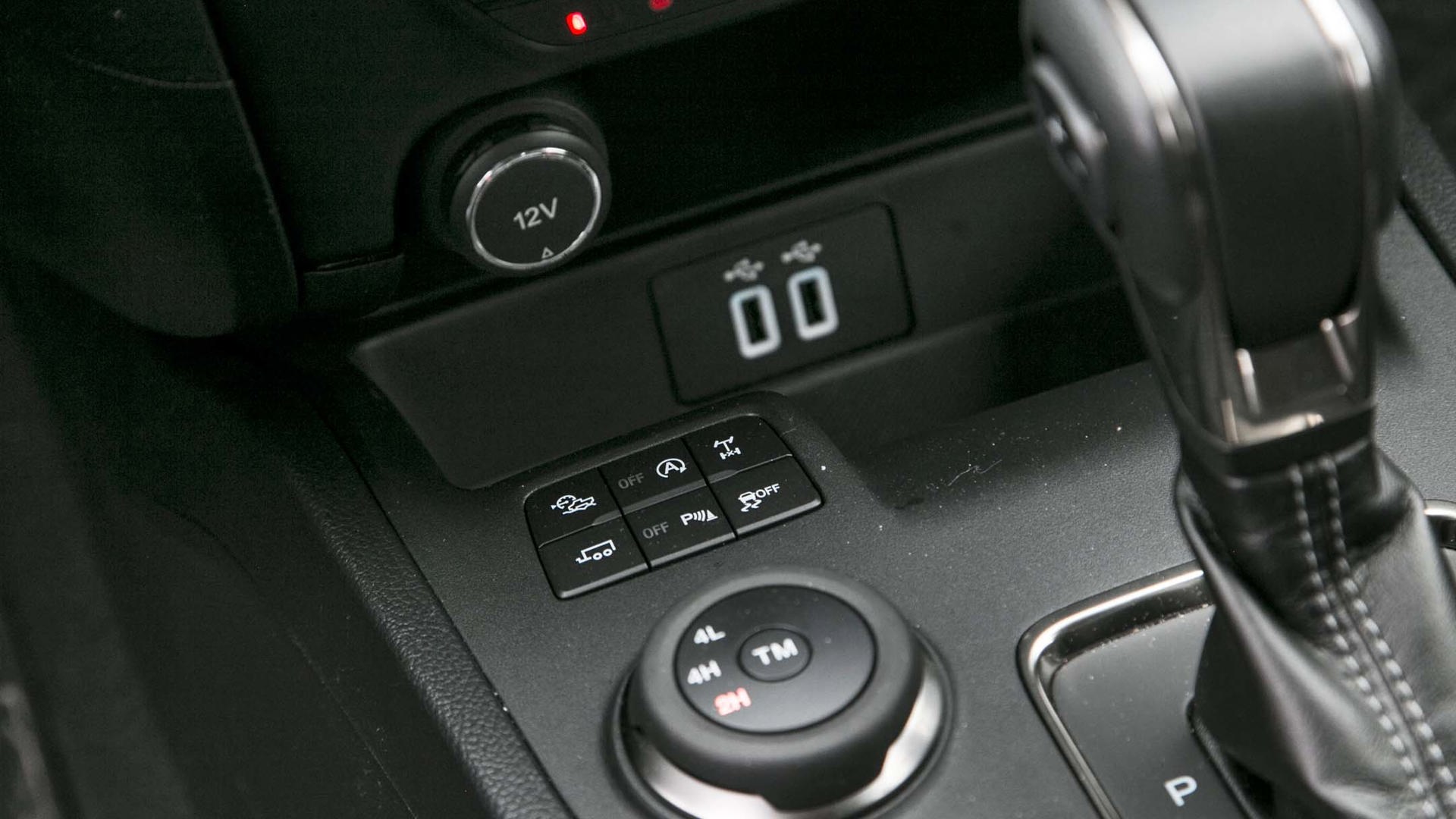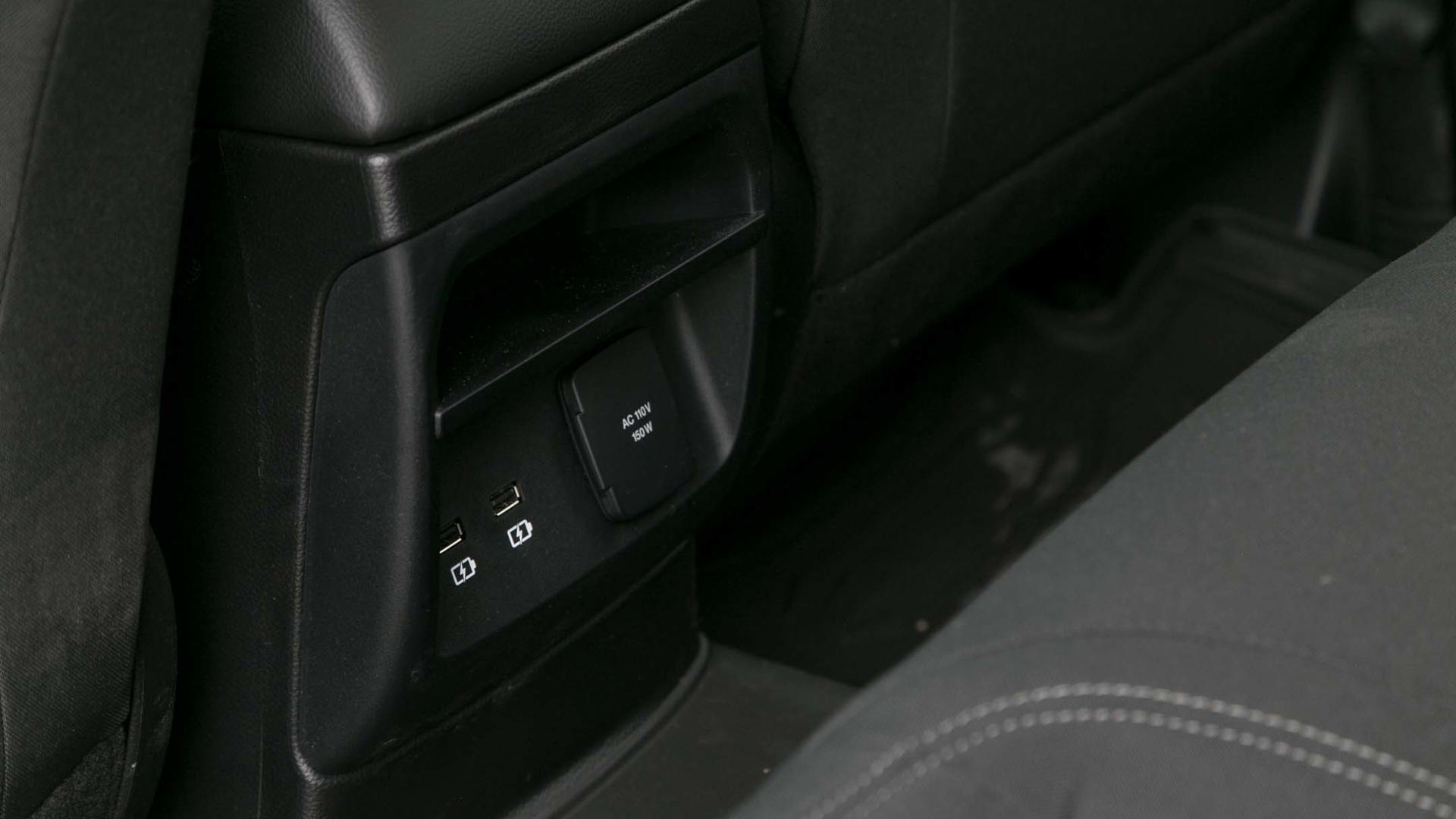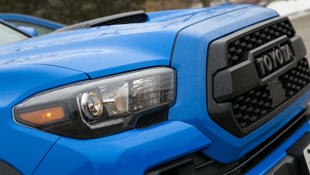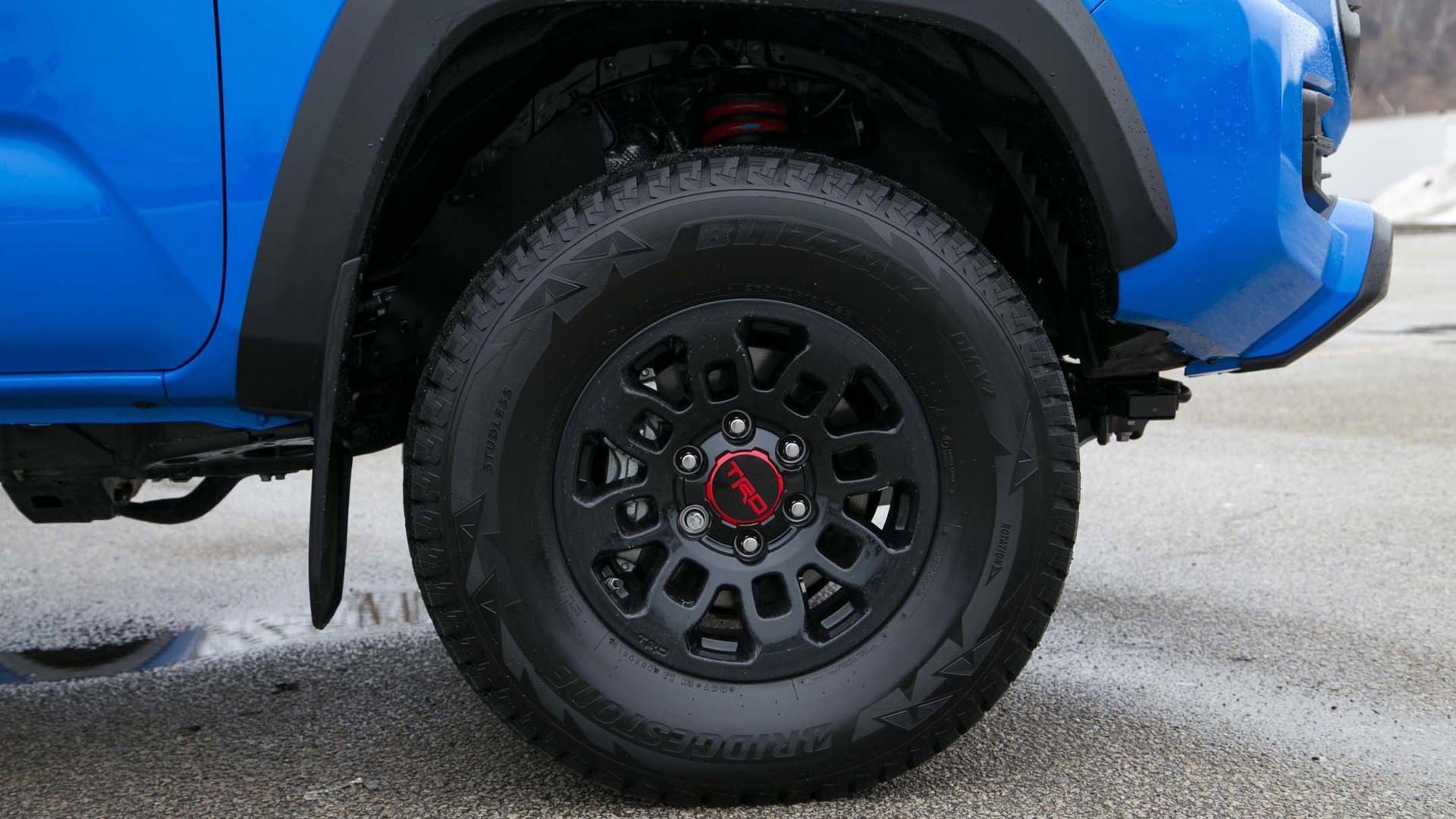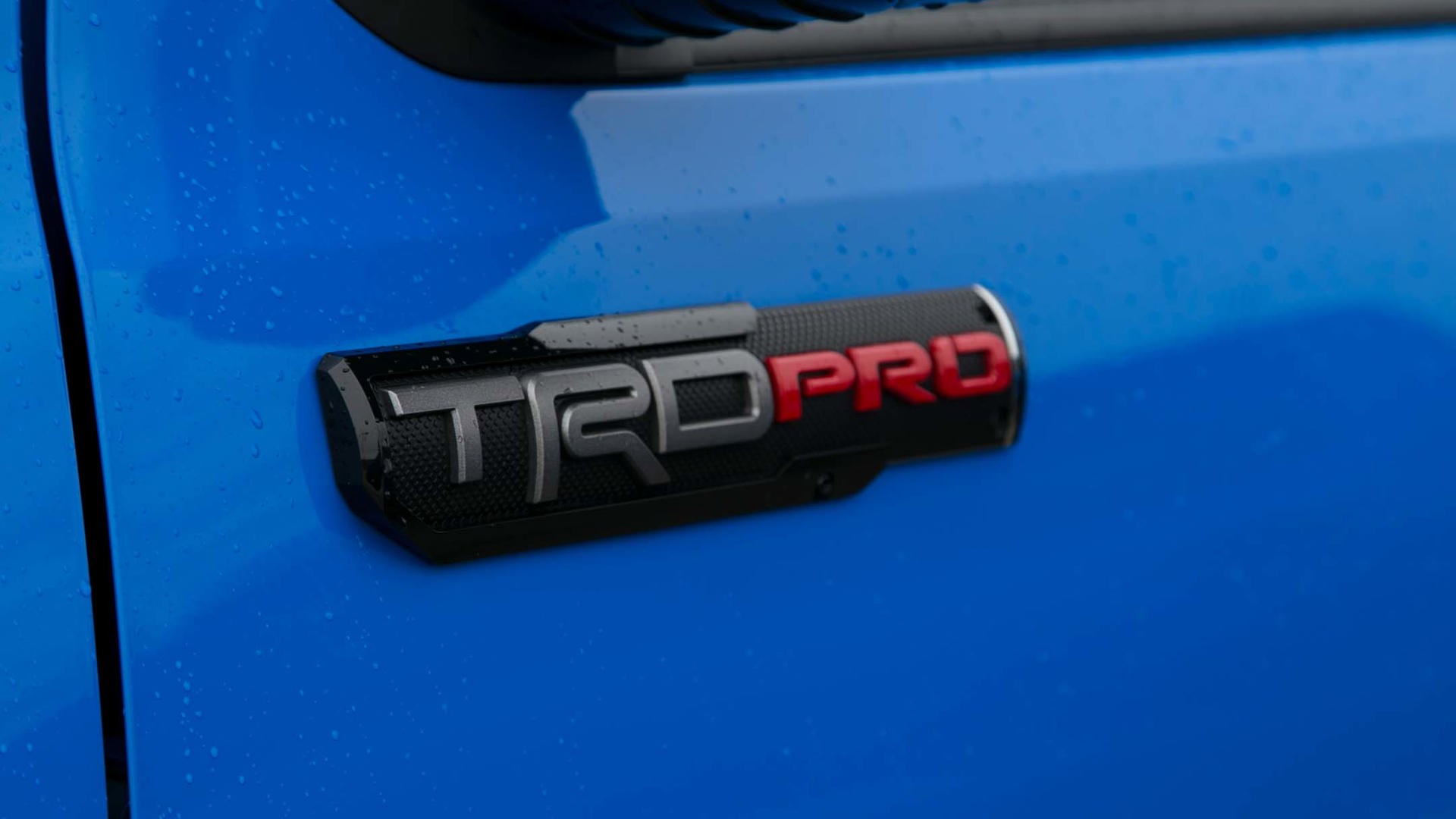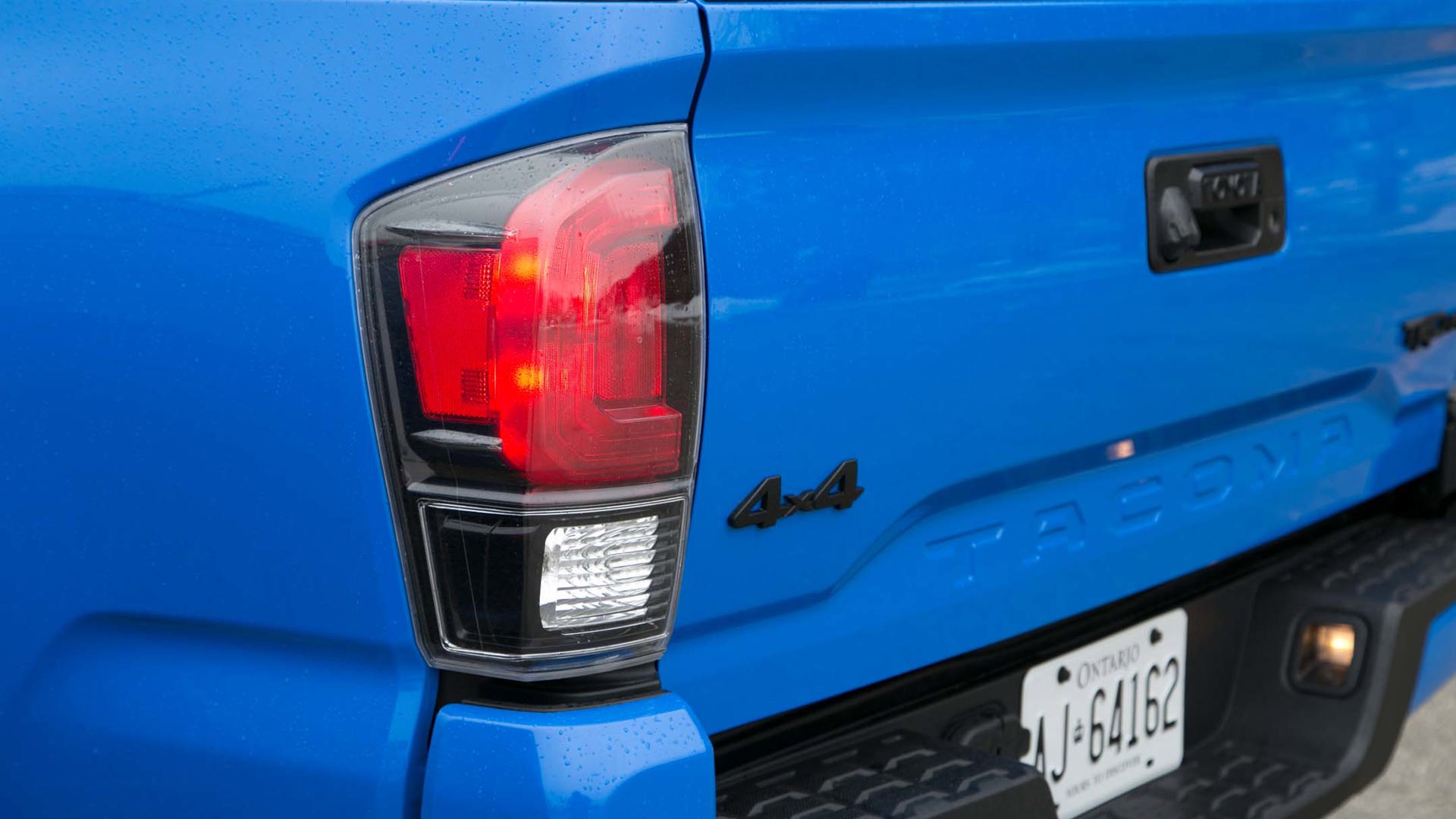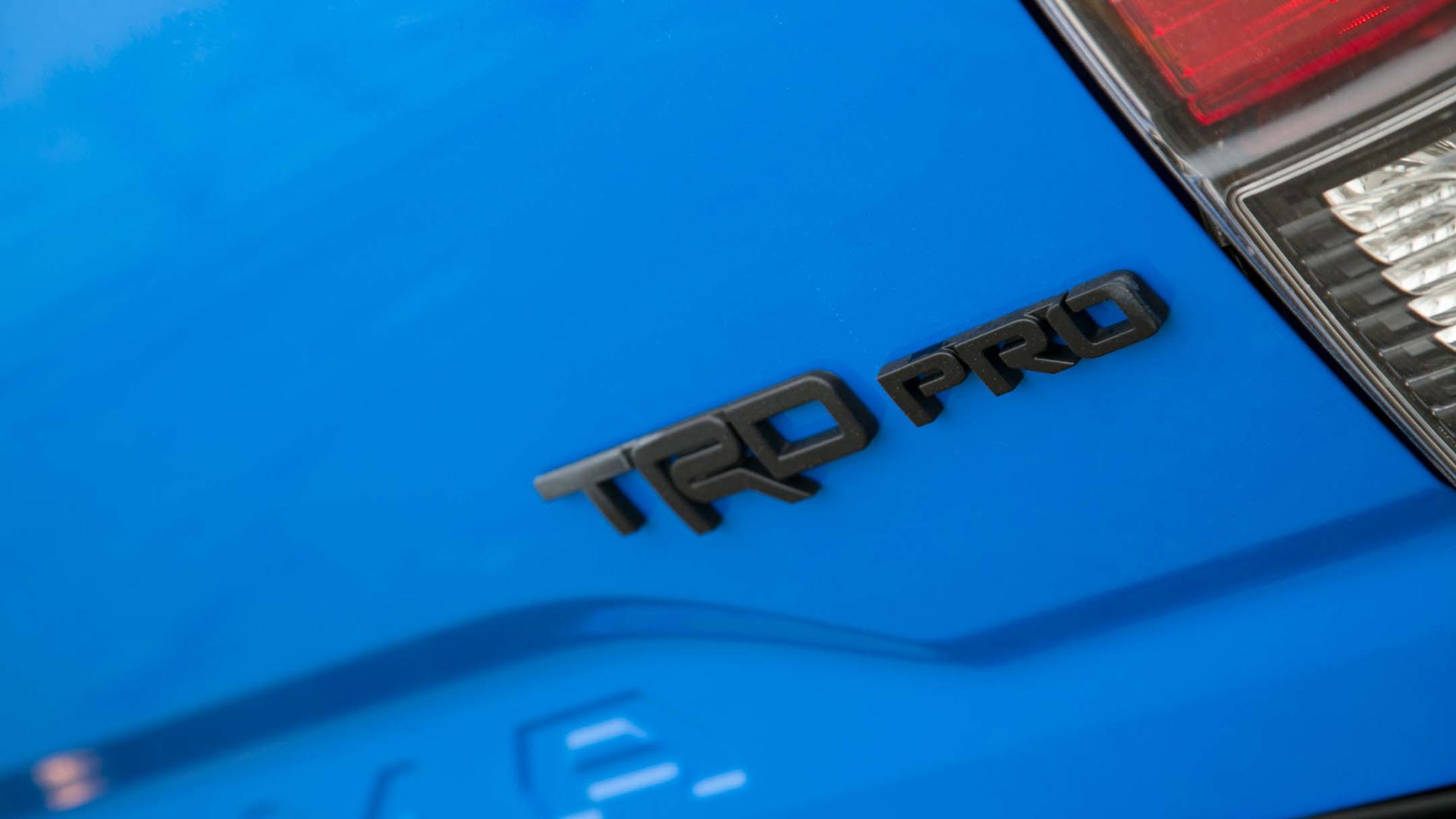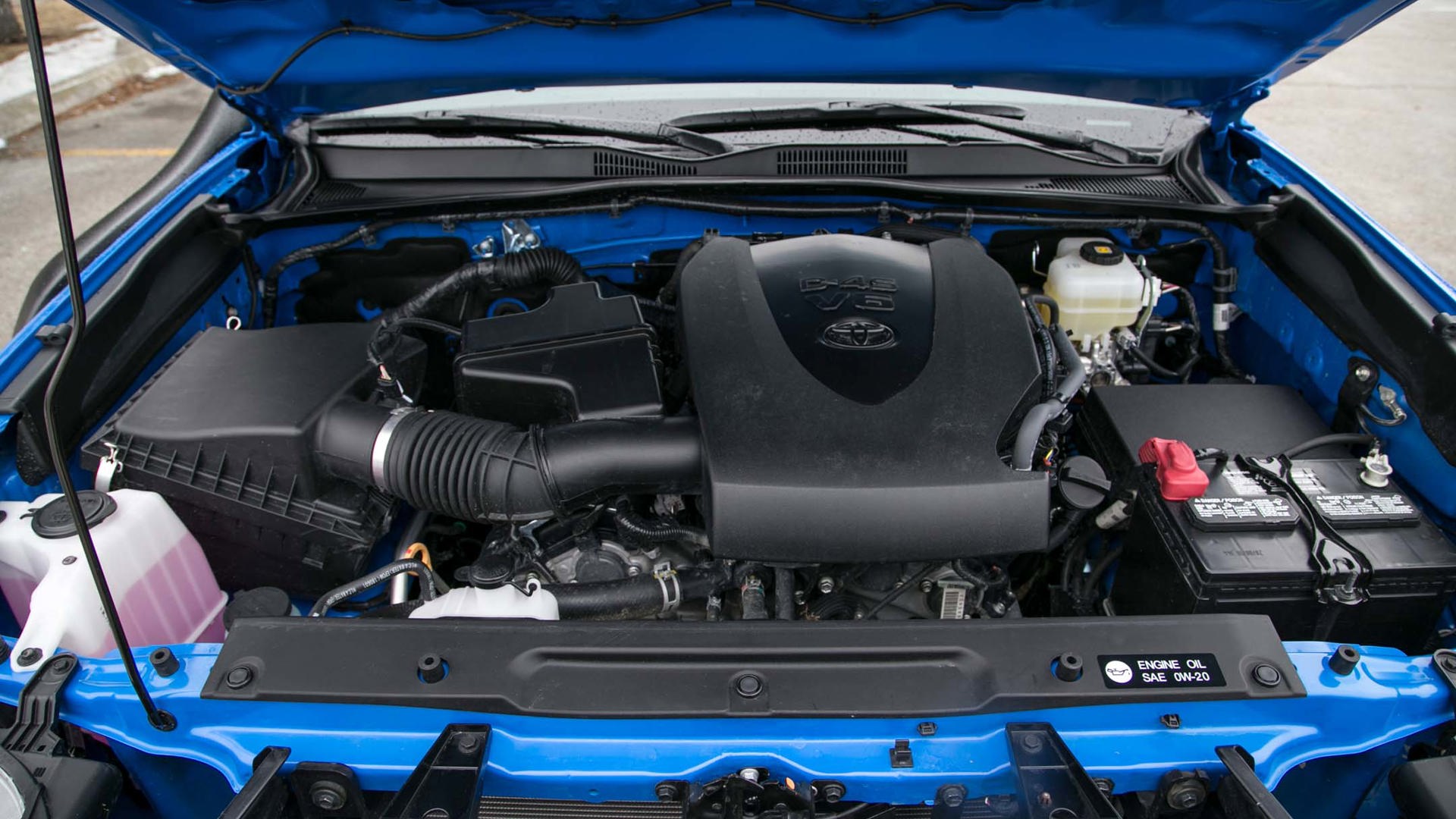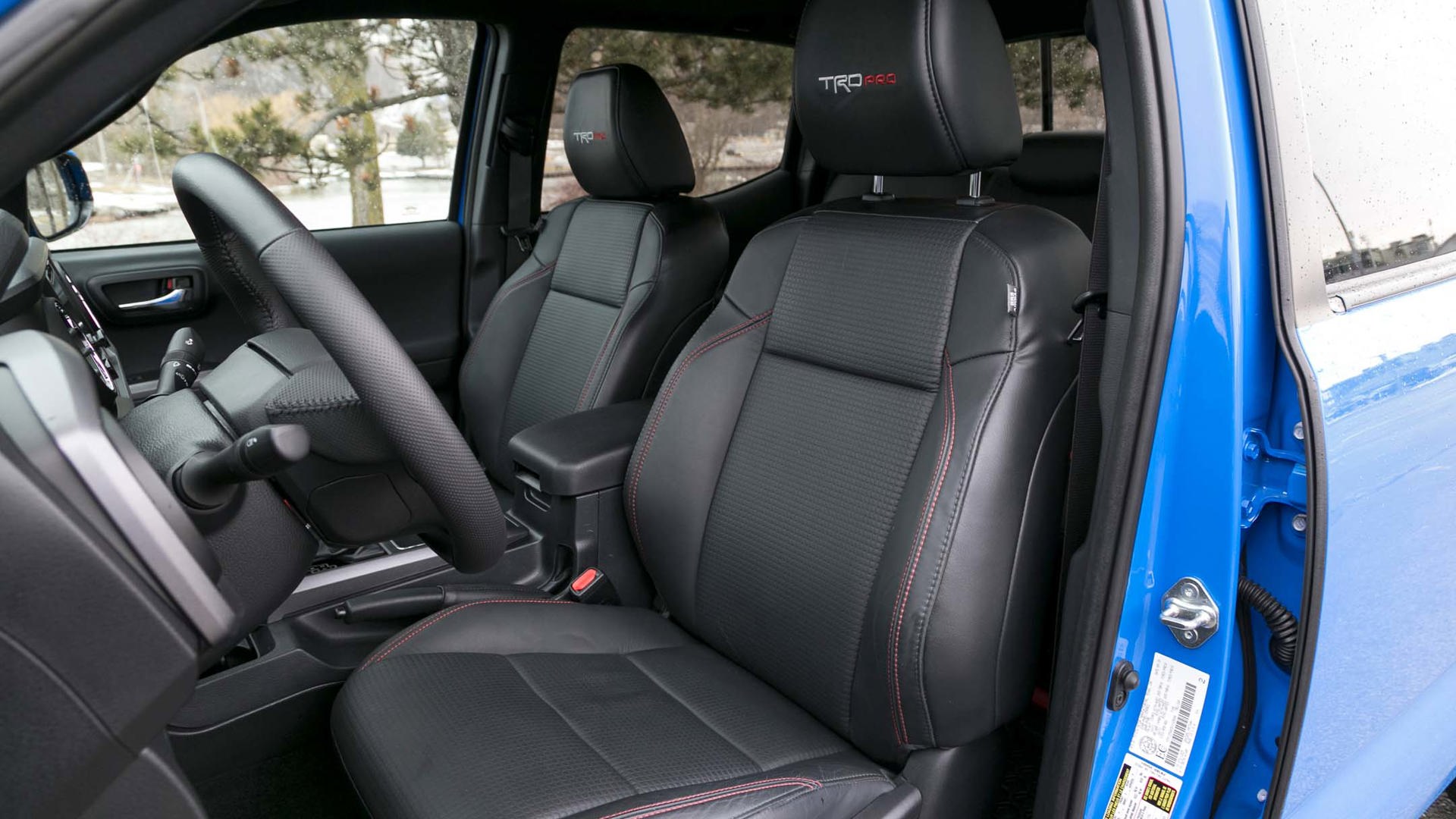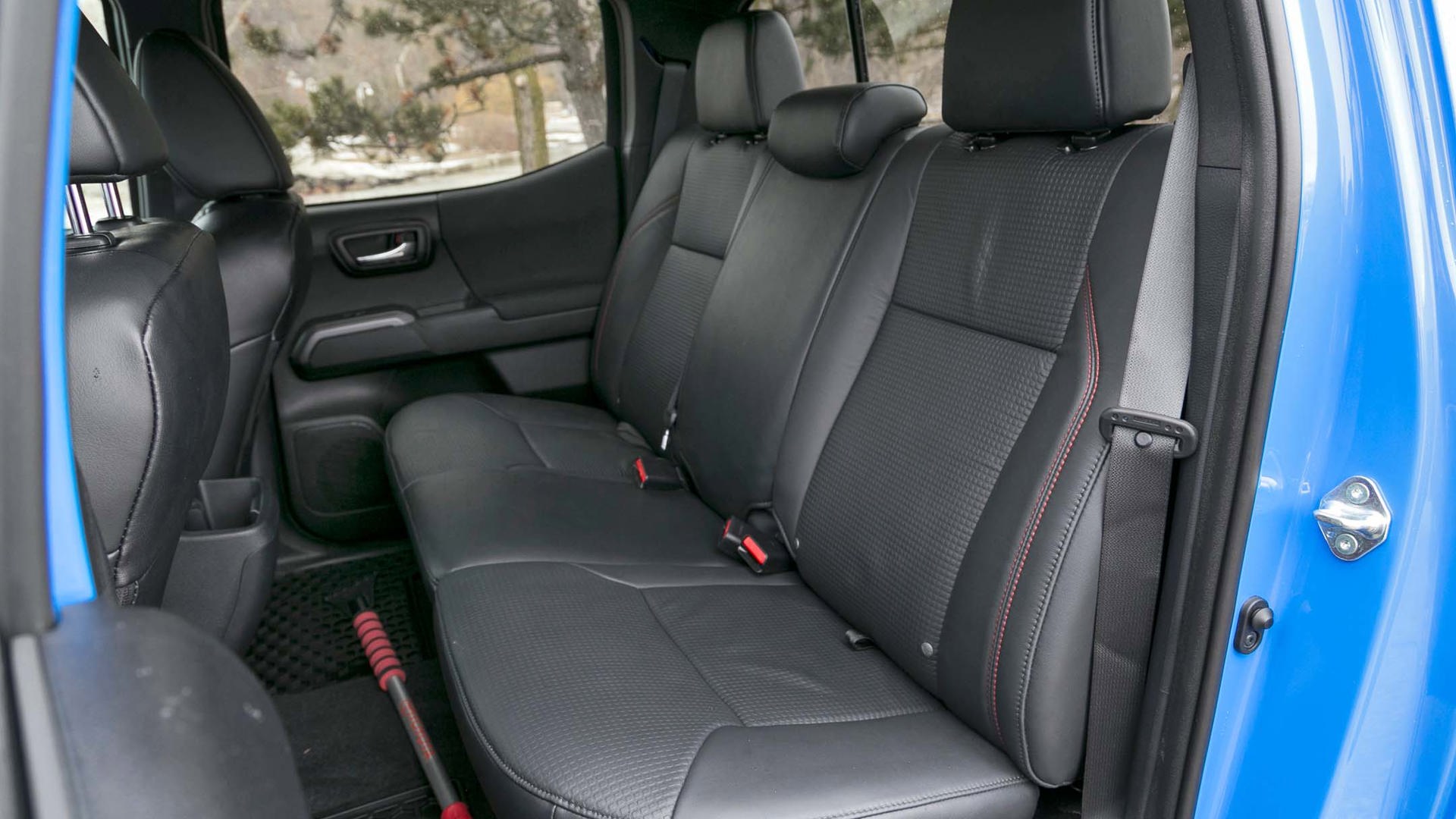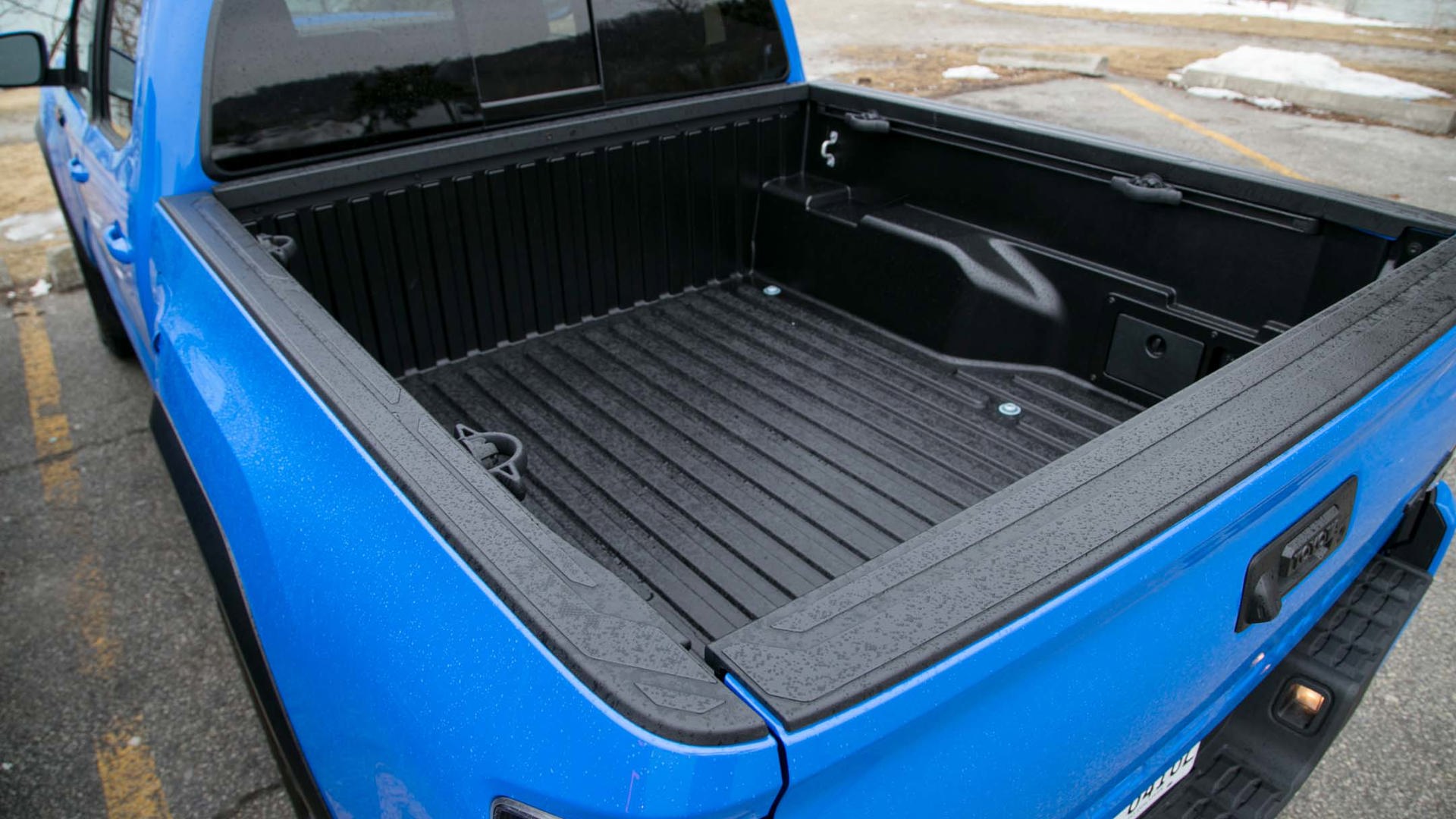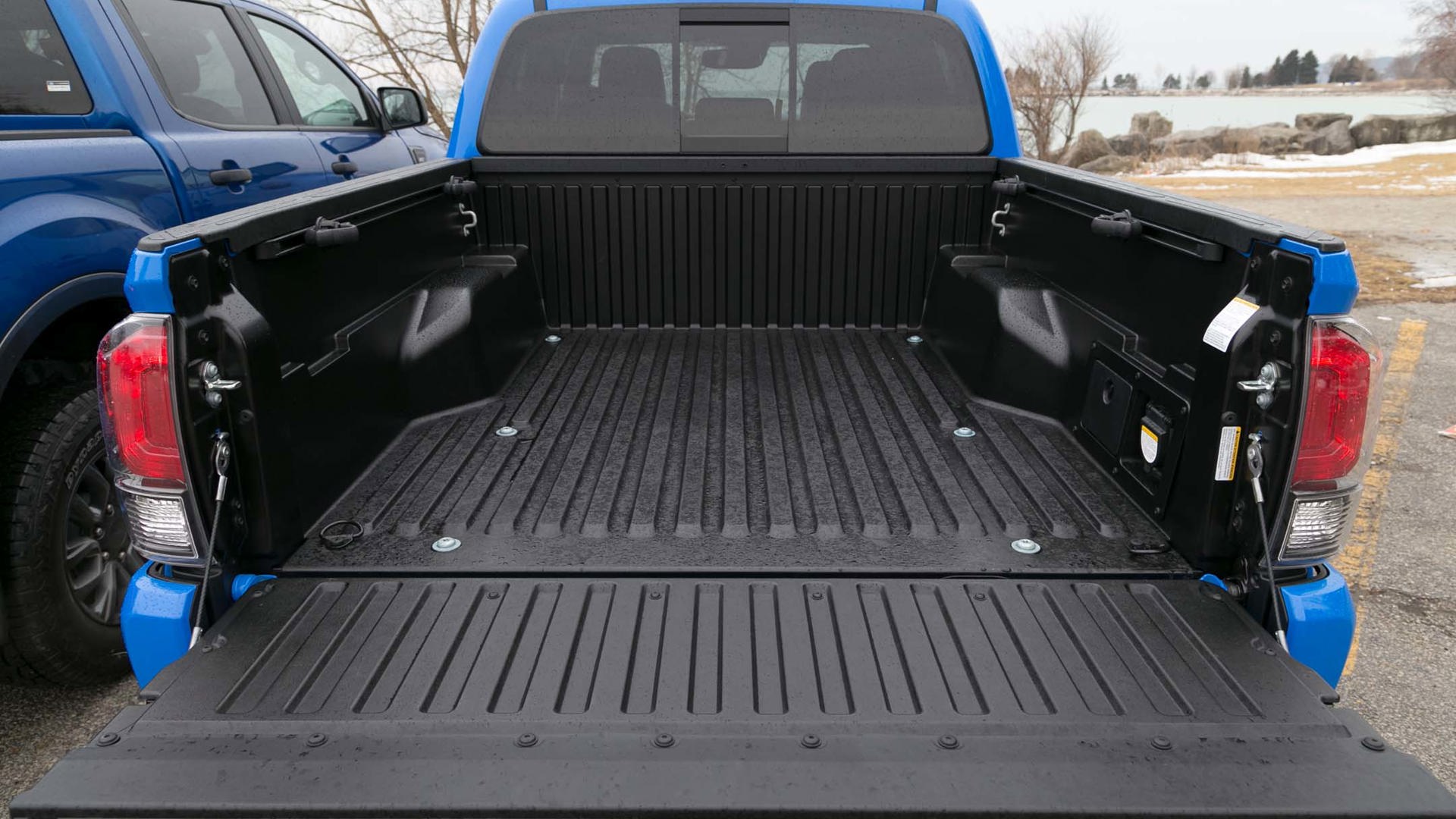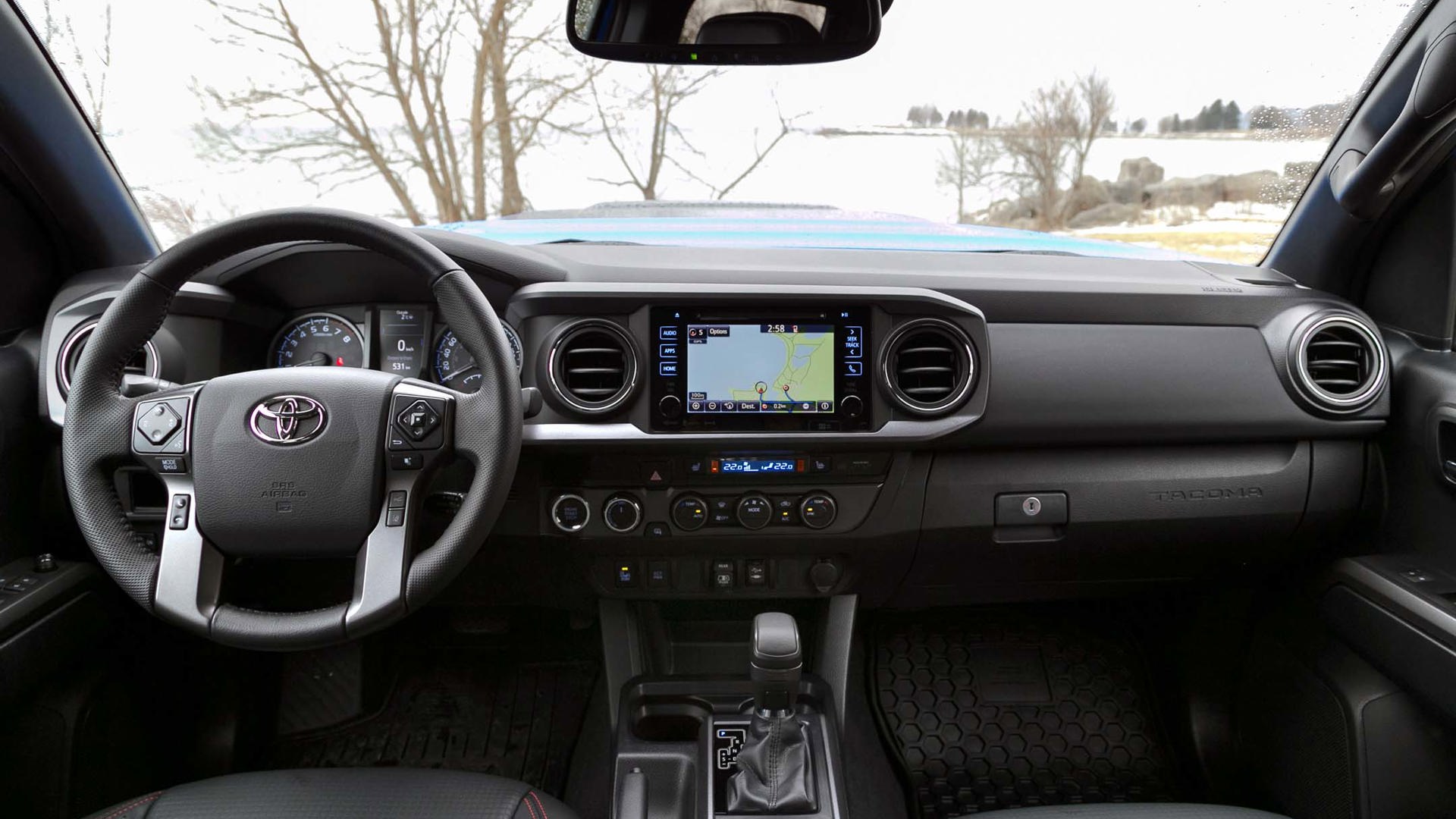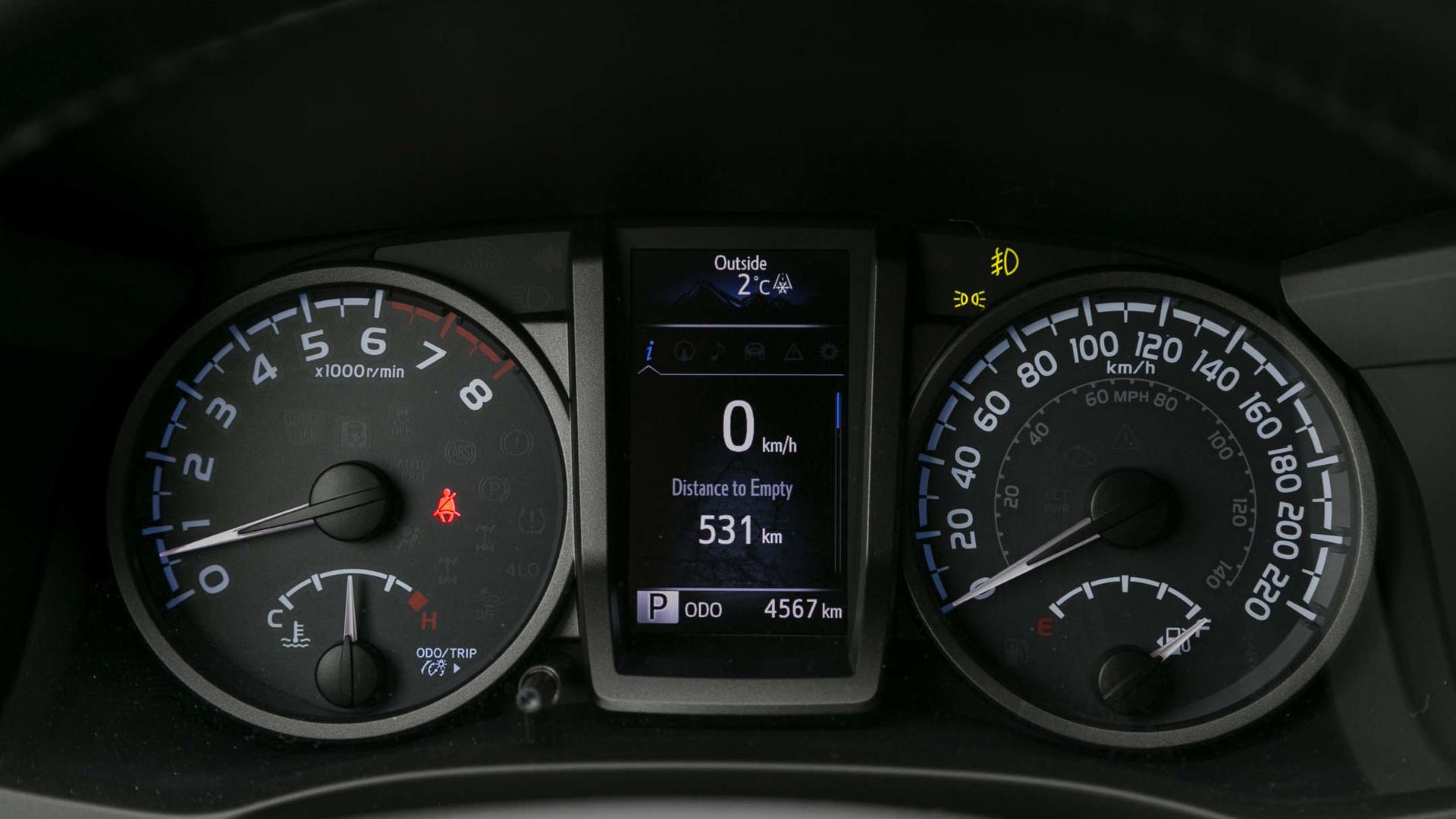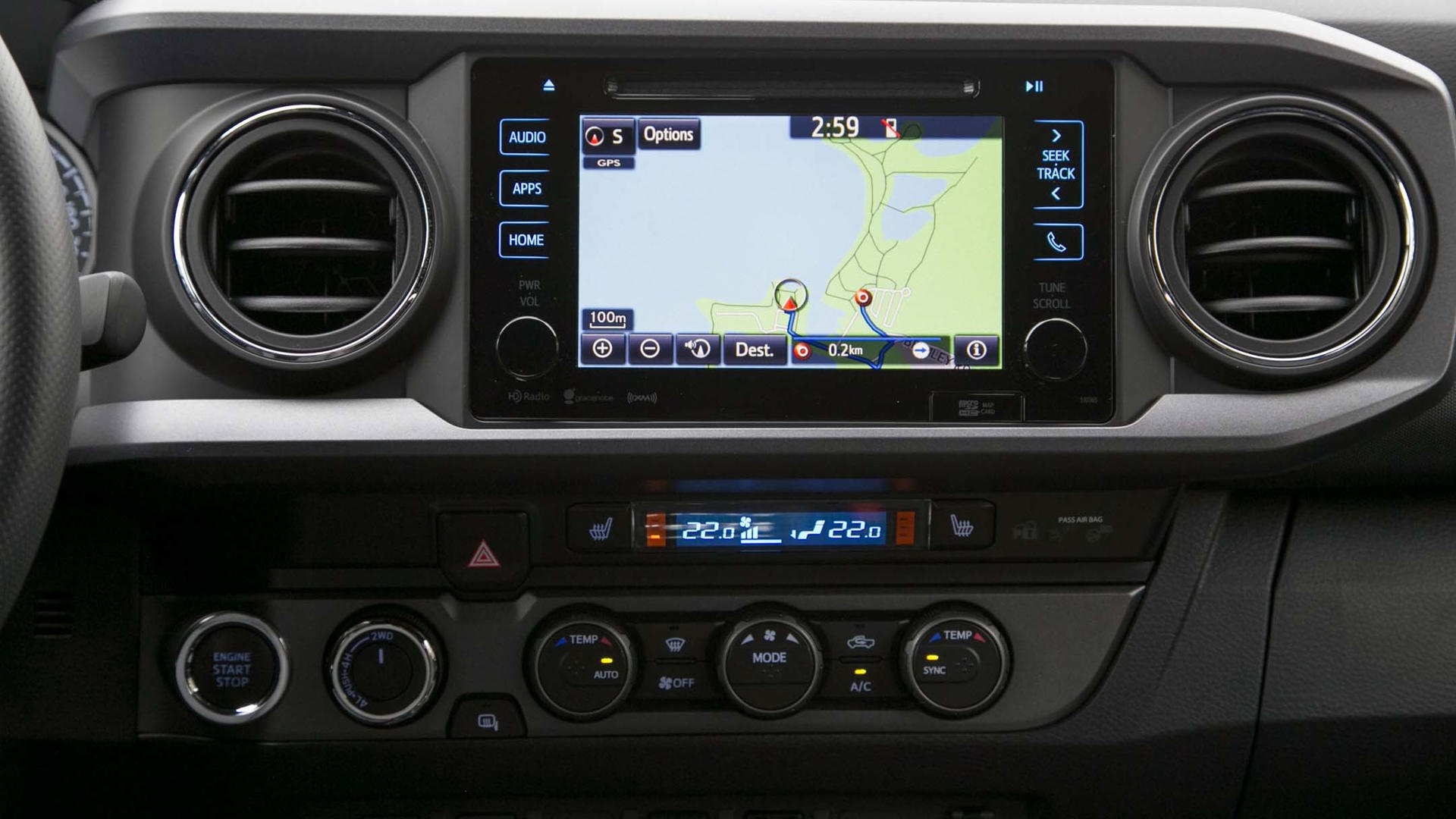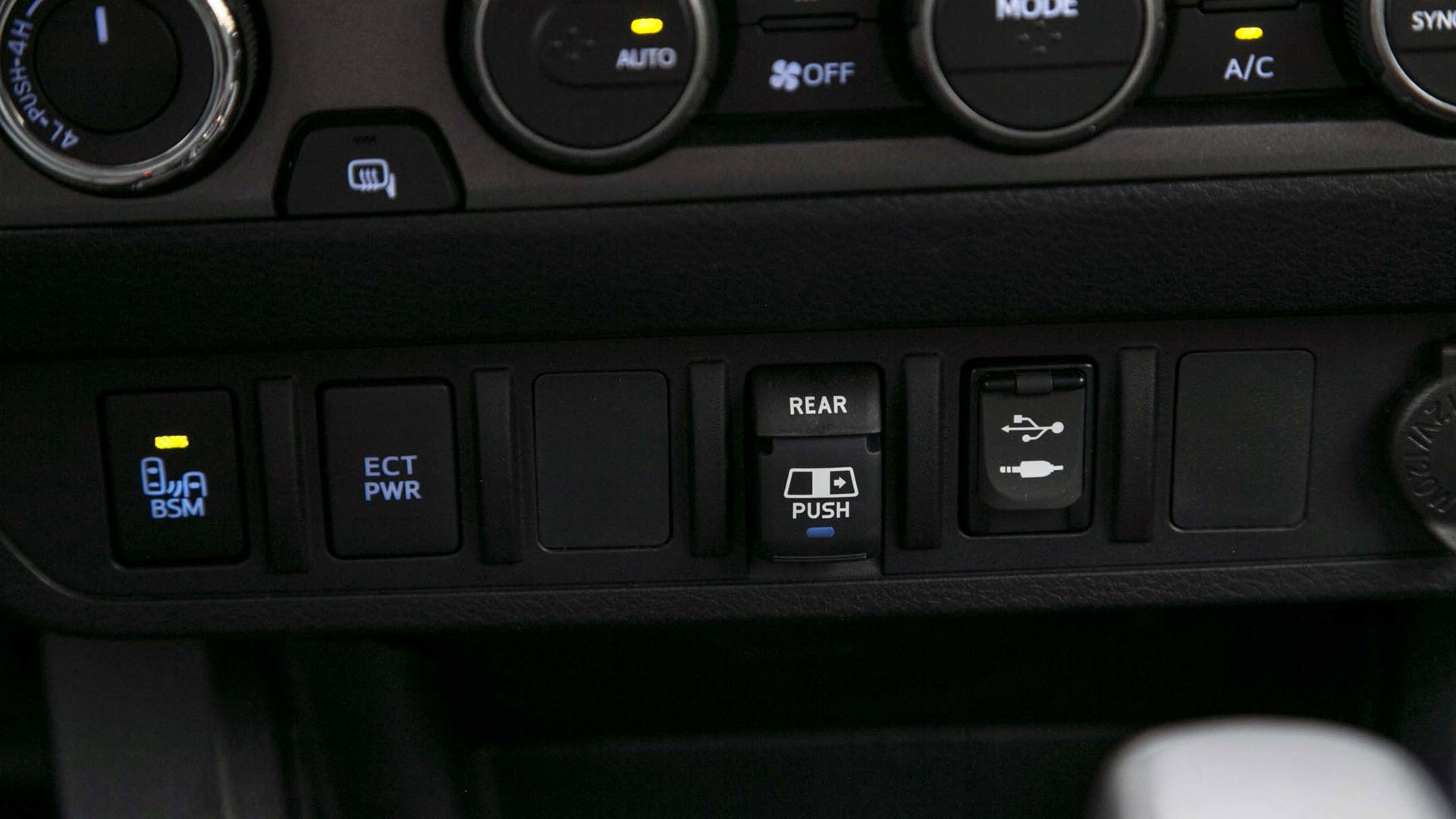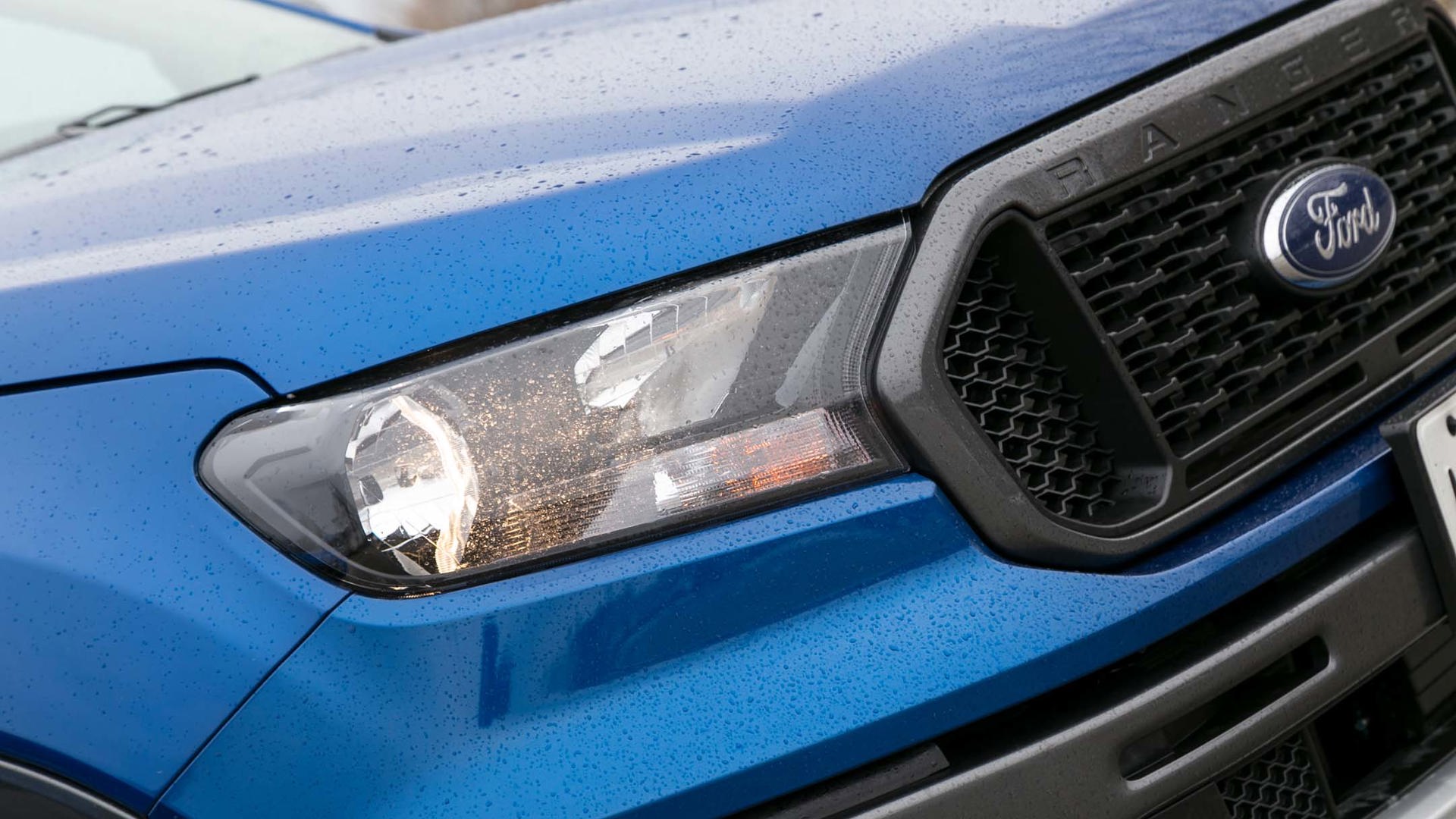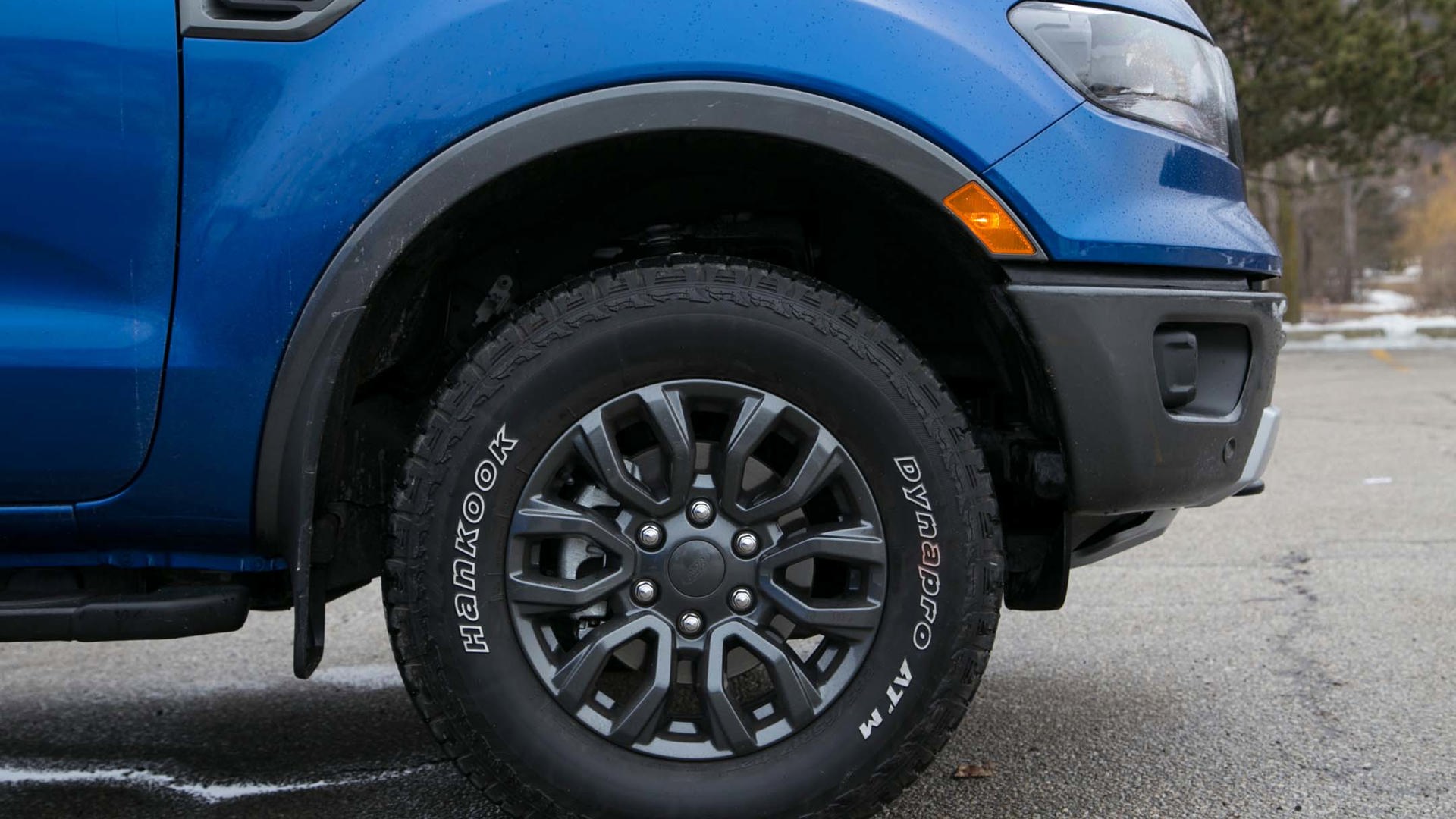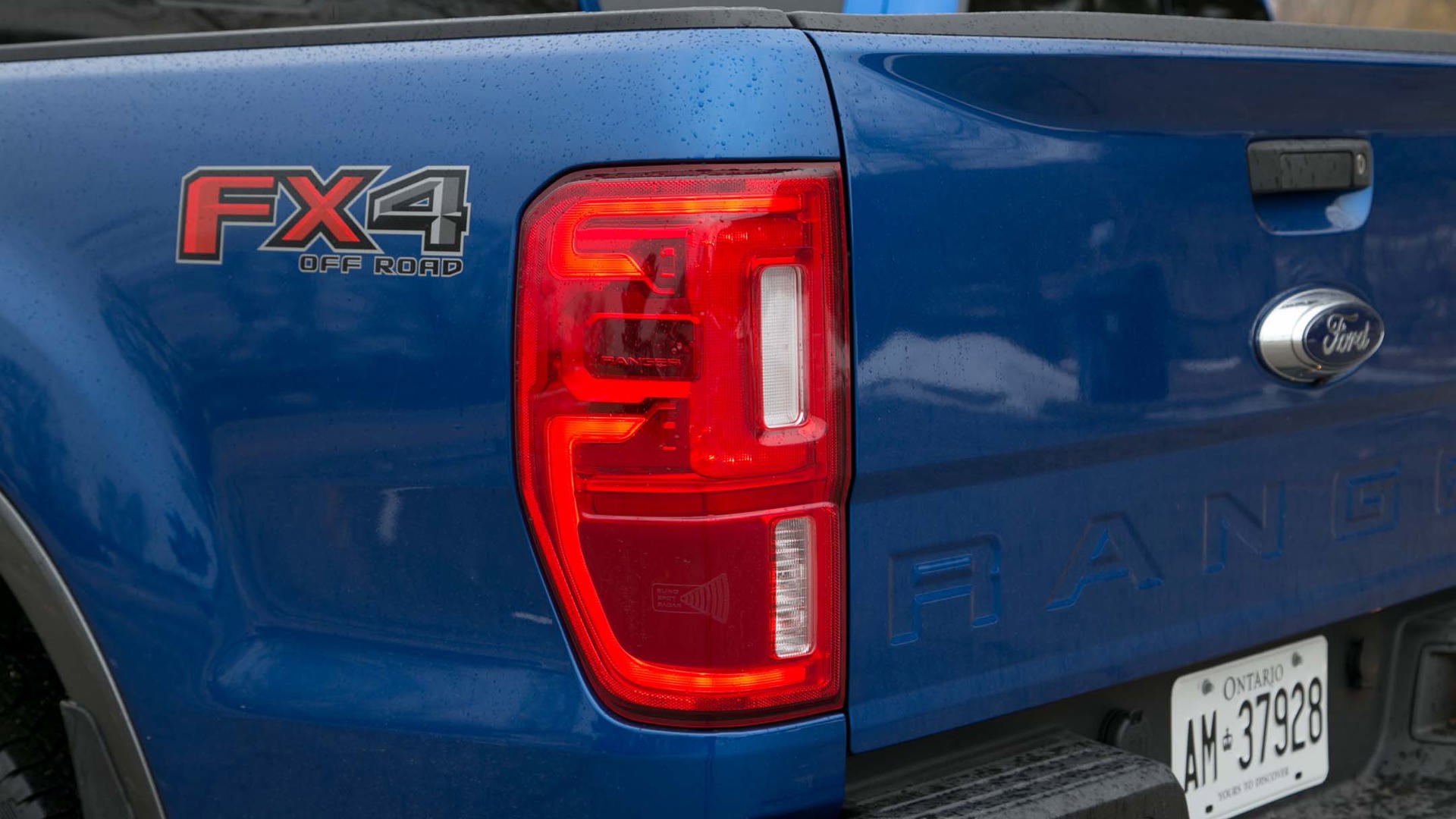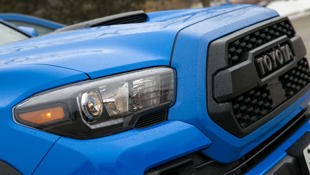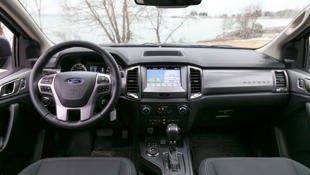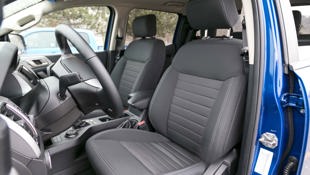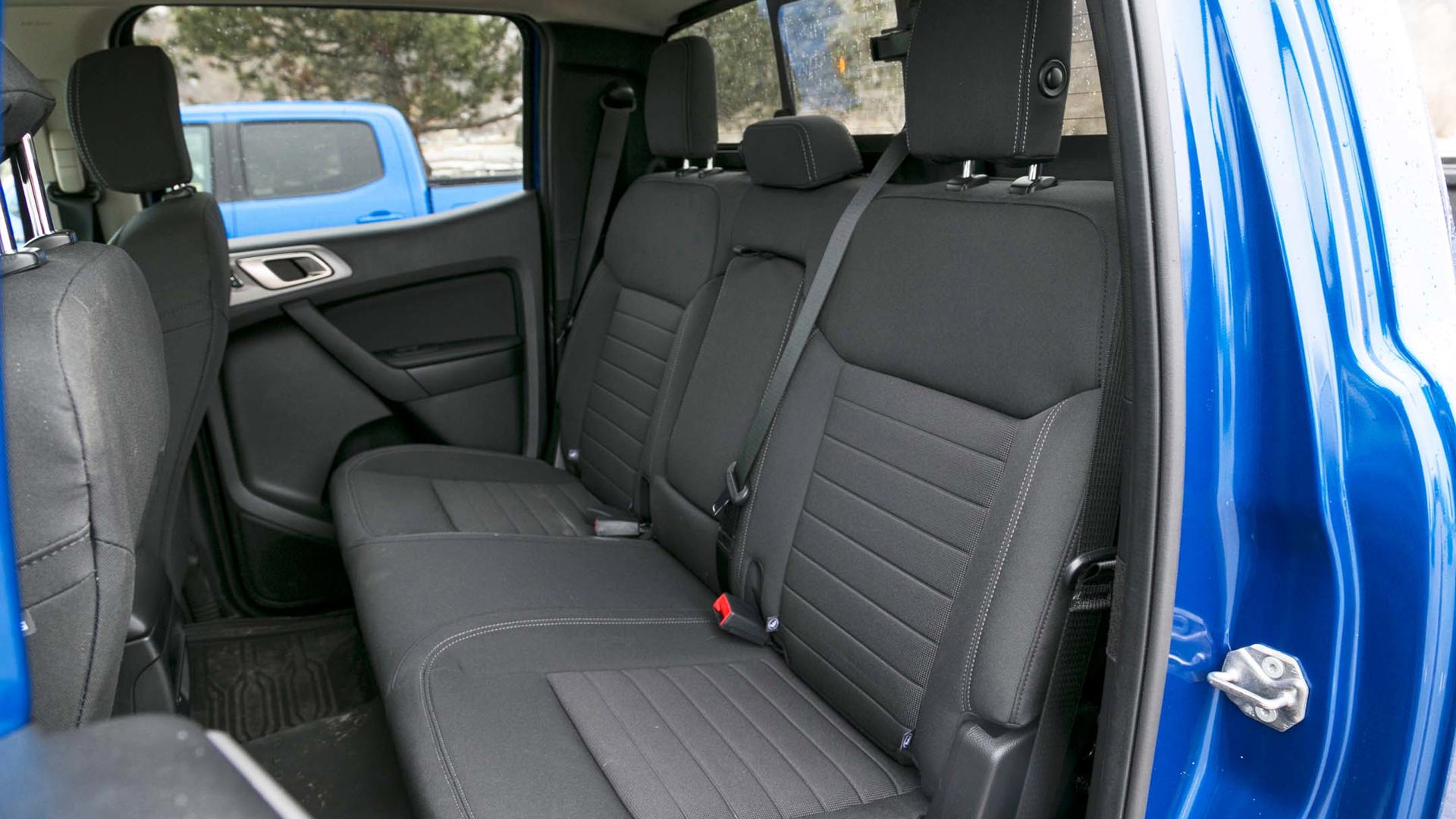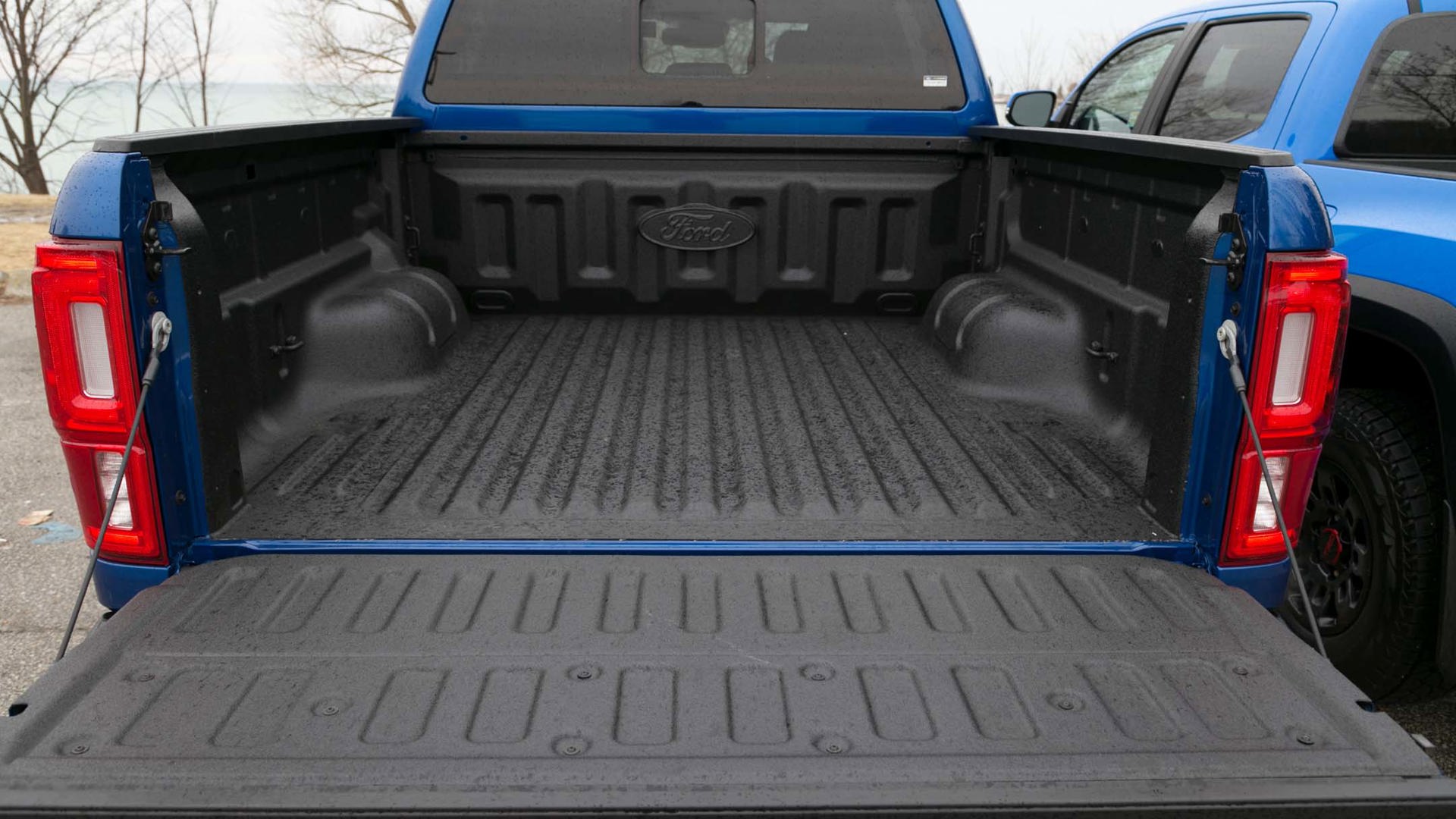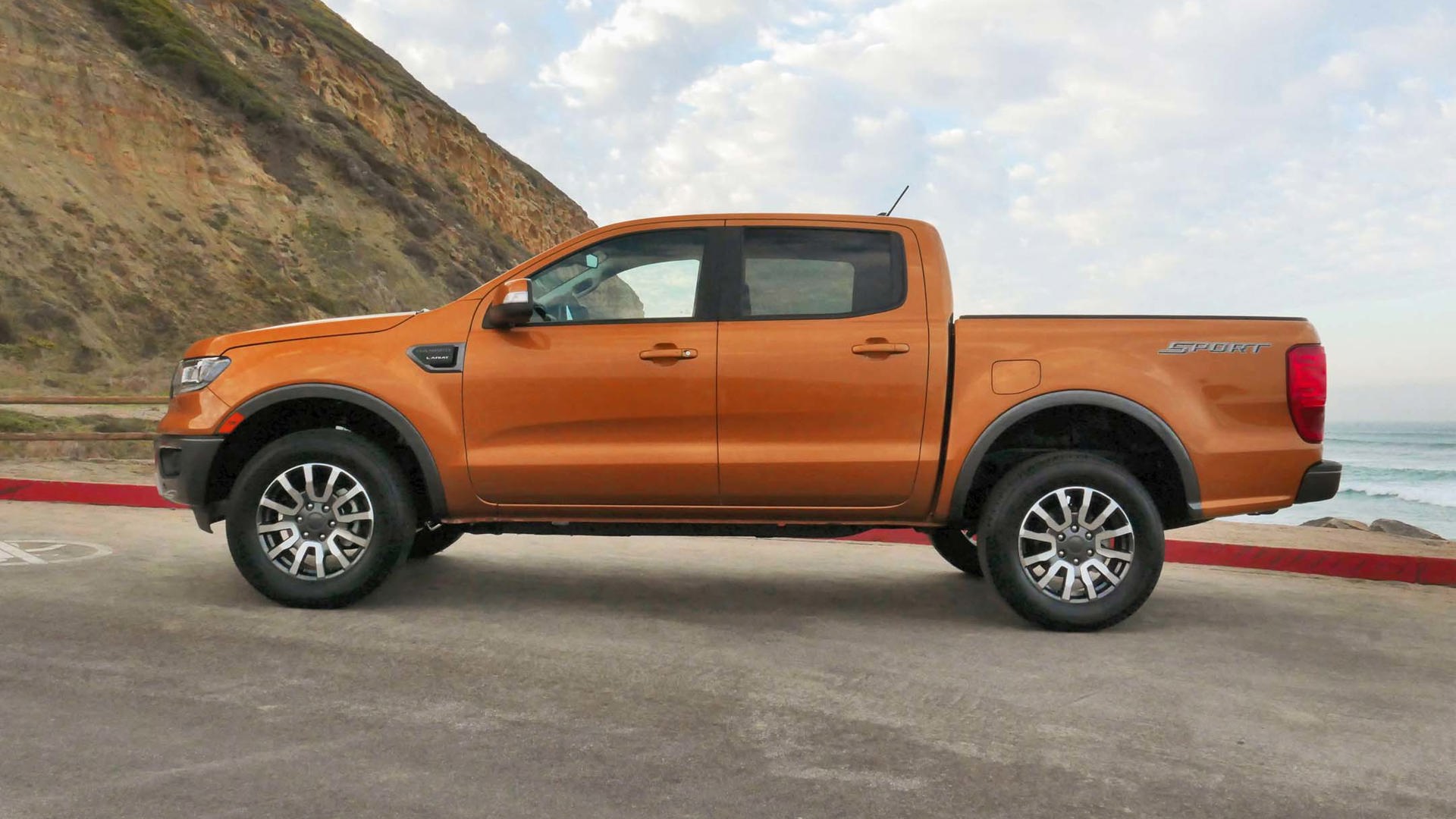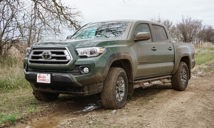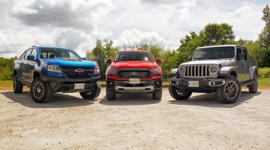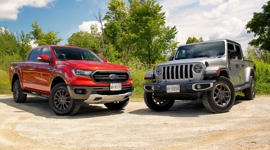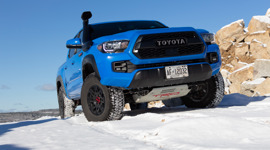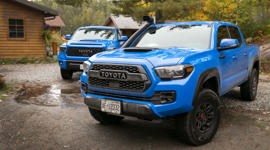Comparison Data
|
2019 Ford Ranger Crew Cab 4x4
|
2019 Toyota Tacoma 4x4 Doublecab V6 6A Shortbox
|
|---|---|
|
Engine Displacement
2.3L
|
3.5L
|
|
Engine Cylinders
I4
|
V6
|
|
Peak Horsepower
270 hp @ 5,500 rpm
|
278 hp @ 6,000 rpm
|
|
Peak Torque
310 lb-ft @ 3,000 rpm
|
265 lb-ft @ 4,600 rpm
|
|
Fuel Economy
11.8/9.8/10.9 L/100 km cty/hwy/cmb
|
13.0/10.5/11.9 L/100 km cty/hwy/cmb
|
|
Cargo Space
1,550 mm box
|
1,536 mm box
|
|
Base Price
$37,339
|
$42,940
|
|
A/C Tax
$100
|
$100
|
|
Destination Fee
$1,900
|
$1,815
|
|
Price as Tested
$47,309
|
$58,350
|
|
Optional Equipment
$7,970 – XLT Package $3,500; Technology Package $850; FX4 Off-Road Package $1,400; Mud flaps $150; Floor Liner $170; Running Boards $700; Trailer Tow Package $600; Spray-in Bedliner $600
|
$13,495 – TRD Pro $13,495
|
Within moments of picking up a gleaming blue 2019 Ford Ranger, I noticed it was generating a lot of attention from my fellow motorists. When driving around in Skittle-coloured sporty exotics, one expects this sort of reaction, but not so from a new pick-up, especially one that’s been available elsewhere in the world for a few years, even if it’s only now reaching dealerships here.
What it shows is that Canadians still love their trucks, and while most of the gawking came from fellow truck drivers, my Instagram post of the Ranger generated a lot of response from people who don’t typically comment on my automotive posts, making me wonder what the heck Ford was thinking during the last eight years they’ve neglected to offer a Ranger in our market.
It was the guy driving the grey Tacoma contorting himself to snap a cell phone pic of the new Ford that reaffirmed the need to compare Ford’s newest truck to Toyota’s venerable mid-size rig.
Toyota’s media department was kind enough to offer up a Voodoo Blue 2019 Tacoma TRD Pro with very short notice, and while this top-tier trim isn’t a direct competitor, price-wise, to the mid-level XLT trim Ranger, most of the important details – powertrains, hauling, and yes, even the infotainment systems – are highly comparable.
While full-size truck sales stagnated in the US (and actually decreased in Canada) in 2018, sales of compact trucks increased, with the Tacoma being the sales leader (unless you consider the GM Colorado and Canyon twins together). The overall sales numbers of these smaller rigs still fall well short of their bigger siblings, but make no mistake, the mid-size pickup truck market is an important one for the manufacturers who are participating in the segment.
Exterior
Style is a subjective thing, and being trucks, shouldn’t we be more concerned with functional matters over form? Yes, but one look around the promenades and parking lots of, well darn near anywhere in North America, and you’re going to see a lot of pickup trucks (sometimes very expensive and very fancy ones) that aren’t being used for anything more than a status symbol or fashion statement.
So, to that end, we’ve got a pair of trucklets here that grabbed plenty of eyeballs around the Greater Toronto Area.
Tacomas are a pretty common sight these days, with Toyota’s sales having increased sharply last year, but the TRD Pro trim really stands out, especially this year with the standard “high-mount desert intake” shooting proudly up along the passenger-side A-pillar. The steel skidplate with bright red lettering is about as subtle as a facial tattoo, and those black TRD wheels and badging accent the fantastic blue hue. It’s a butch-looking truck that can back up its machismo with some serious off-road chops (as I discovered last autumn up north), but that snorkel-like appendage is a little silly especially since it doesn’t help water fording, but is simply designed to help reduce dust ingestion by the intake when desert running. Not many deserts around here, so it makes about as much sense as wearing a goalie mask to go shopping.
Our Ranger came with the FX4 Off-Road package which helps toughen up the softer-looking Ford with charcoal grey trim and an even bolder steel bash plate on the front than the Toyota. The Ranger’s nose is a smoother, cleaner design than the Tacoma’s too, and with a less vibrant shade of blue paint, the overall effect is a more grown-up appearance.
The profile features a squatter greenhouse and taller box. If there’s a failing to the Ranger’s appearance, it’s from the rear where it looks awkwardly tall and skinny, but with oversized taillights.
Interestingly, both trucks have their names stamped into the tailgate sheet metal, though the Ford’s can be read from half a kilometre away.
For points, let’s award a point to each the Toyota for its bravado and the Ranger for its sensible styling.
Interior
Regardless of whether these trucks are going to be used for work or for play, they need to keep their occupants safe and comfortable. Adding in a few conveniences doesn’t hurt either.
Despite being new to this market, the Ranger’s interior design shows its age. Internationally, this generation has been on sale since 2015, and some of the interior pieces – like the giant swath of cheap grey dashboard plastic – speak to an earlier time. Ergonomically it’s all pretty functional, except for the hard-to-see climate control buttons placed quite low on the centre stack.
Ford’s SYNC3 infotainment system is offered here and the 8-inch touch screen has bright and contemporary graphics, unlike those on the Tacoma’s dated, 7-inch screen. The Ranger has Apple CarPlay and Android Auto; the Toyota will finally get CarPlay – next year. Both trucks have decent-sounding audio systems.
The Tacoma’s interior features higher-quality materials, but its manually adjustable leather seats were not only extremely hard, but the notorious legs-straight-forward driving position combined to make the Toyota quite uncomfortable after even very short drives.
Conversely, the plain cloth seats in the Ranger proved to be supportive and very comfortable even after logging a lot of miles.
Rear seats in both trucks have very comparable dimensions with the Ranger having slightly more leg room, but the Tacoma offers up greater hip and shoulder room.
Despite its higher-quality materials, driver discomfort and the substandard infotainment system in the Toyota are inexcusable. Ford earns a point here.
Utility
Regardless of whether or not it will actually be used for utility, any pickup truck worth its salt needs to be able to be a dependable, rugged, and capable tool when truck jobs arise.
If those tasks require some off-road driving, Toyota’s Tacoma with the TRD Pro option is pretty formidable. Objectively, its ground clearance is superior to the Ranger’s, as is its approach angle (though just barely), but the Taco’s wheelbase is notably longer, so its ground clearance won’t help much for breakover angle. The Tacoma’s standard rear hitch receiver hangs down lower than the Ranger’s contributing to a worse departure angle, and neither truck had very obvious or easily accessible tow points in the rear, short of using their hitch points.
Where the TRD Pro steps up the off-road game is with superior all-terrain tires (although our test rig wore Bridgestone Blizzak winter rubber), and front and rear Fox shock absorbers that enabled me to take a series of “speed humps” at nearly 60 km/h. By comparison, the bouncy Ranger lost its composure by 50 km/h over the same humps (most cars need to take them at less than 40 km/h). All that said, Chevrolet’s Colorado ZR2 Bison and the upcoming Jeep Gladiator are likely to be even more capable off-road than either of these trucks.
As spec’ed, both the Ranger and Tacoma had five-foot boxes on paper. Despite that, the Ford’s box was slightly longer, wider, and deeper than the Toyota’s, and even more importantly, it offered up a significant payload advantage over the Taco’s. But the Ranger had four rudimentary tie-down loops, versus the Tacoma’s series of sliding cleats and stainless steel tie-downs. The Ranger can also be equipped to tow 500 kg more than the Tacoma, although it’s the Toyota that comes standard with a Class IV weight distribution hitch.
The Tacoma’s rear seat folds flat, offering a durable parcel tray, while the Ranger’s rear seat does not fold flat and offers no additional utility.
If we were comparing apples to apples here, a Tacoma TRD Off-Road is more closely aligned in specs and price to the Ranger XLT FX4 than our TRD Pro. Take away the TRD Pro’s fancy shocks and the Ranger’s greater capabilities for towing and hauling make it the clear utility winner.
Driving
Most of these trucks are realistically going to see little-to-no off-road action, so their on-road performance is key.
Ford has fitted all Canadian Rangers with a 2.3L EcoBoost four-cylinder engine. Tuned as it is here, it puts out 270 horsepower and much more importantly, 310 lb-ft of torque. Likewise, all Rangers here direct power to all four wheels via a pair of Dana Trac-Lok differentials, with the rear being electronically lockable. A ten-speed automatic is the only transmission offered, and while I’ve been thoroughly impressed with this gearbox application in each the Silverado and the F-150 full-size trucks, here it felt out of sorts. In particular, around town, downshifts under moderate throttle were often clunky.
2WD high, 4WD high, and 4WD low are available, along with an electronic crawl function and various computerized terrain modes are offered in both trucks as part of their respective off-road packages, and all selected by electronic rotary dials.
The Tacoma’s Atkinson-cycle six-cylinder dispenses 278 horsepower, but only 265 lb-ft of torque at significantly higher revs than the Ford’s peak twist. This means that whether tootling around town, or trying to pass at highway speeds, the Toyota’s bigger engine always feels like it is working a lot harder to get the job done.
This sensation is exacerbated by the programming of Toyota’s six-speed automatic which seems to always want to work its way up to top gear as quickly as possible, resulting in a lot of up and down shifting even to keep itself up to highway speeds on small inclines.
The noise emitted from the Tacoma’s TRD exhaust was loud and offered up all the aural pleasure of a damaged trombone blaring inches from your head. By contrast, the Ranger’s engine sounded like an industrial HVAC unit, but at least its cabin was significantly better insulated from road, wind, and engine noises than the Tacoma’s.
The Toyota feels like a truck. Its steering is slow and surprisingly heavy, which is useful when off-road driving to carefully place a wheel where you want it, while slowly crawling. Driving around town or trying to navigate highway traffic, however, it’s less pleasing, but overall, it feels like a solidly built machine.
The Ranger, on the other hand, had impressive on-road manners, cruising comfortably at elevated highways speeds, and feeling downright car-like around the city.
One last complaint about the Taco’s driving manners revolves around its brakes. This particular test unit had a very firm pedal feel with extremely grabby operation making linear braking nearly impossible. I don’t recall this from previous Tacomas, so this could be an anomaly. The Ranger’s brake pedal felt soft, but at least offered smooth braking.
No question here, the Ranger is the more pleasing machine to drive, earning it another point.
Fuel Efficiency
With a significantly smaller engine, the 10-speed transmission and auto-stop/start functionality, fuel efficiency is one of the new Ranger’s calling cards. The Tacoma, with its Atkinson Cycle engine represents an improvement in efficiency over its predecessor, but at a combined average of 11.2 L/100 km, it is still consumes regular gas more thirstily than the Ranger’s 10.9 L/100 km combined average.
After a week of driving around in both trucks, the Toyota was showing an average of 2 L/100 km greater than the Ford’s low 10’s. The Toyota’s fuel tank is 12 L larger than the Ranger’s, which at only 68 L means the Ford has a significantly shorter range.
Both on paper and in the real world, the Ford Ranger takes the point for efficiency.
Value/Quality
This is where the evaluation gets tricky. In terms of quality and value, Toyota is legendary for the durability and longevity of its trucks. The solidity and build quality of our Tacoma suggests the current generation should uphold this reputation for years to come.
Our Ranger had barely 1,000 km on it, and plenty of new-car smell, so it is impossible to accurately predict how reliable these machines will be over time; only how they behave when in our care for a week.
Nevertheless, despite a rigid-feeling structure, our Ranger did have some dash rattles and the forward camera system failed at one point, rendering the emergency stop and adaptive cruise control functionality to crap out – and this was during sunny weather. Are these signs of future reliability concerns? Only time will tell.
While it didn’t have the Tacoma’s fancy off-road suspension, power sunroof or leather interior, the Ranger was otherwise equipped with a similar suite of active safety functions and a tech-heavy infotainment system, netting an as-tested price of 45-grand compared to the Toyota’s sticker more than $10,000 higher.
A more comparably equipped Tacoma TRD-Off-Road package would be pretty well identically priced to our Ranger. Add to that industry-leading resale value for the Toyota and a point has to be awarded here for the Tacoma for value and quality.
Conclusion
The mid-size truck market is an interesting one with some seriously good competitors that range from the unibody Honda Ridgeline, to the GM trucks with their myriad of drivetrain choices, to the affordable Nissan Frontier, and of course, the upcoming Jeep Gladiator. Each of those trucks offer some pros and cons over our Toyota and Ford testers, and are worthy of consideration by shoppers.
Between our two trucks, the Tacoma’s reputation for longevity and durability is surely enough to make some buyers not need to look elsewhere. Based on our week-long test, and tallying up the points from the above categories, it’s the Ford Ranger that turns out to be the better mid-size 4x4 pickup truck.
Ford Ranger: 5 points
Toyota Tacoma: 2 points
